This site uses cookies. View our Cookie Policy to learn more about how and why.
This site uses cookies. View our Cookie Policy to learn more about how and why.
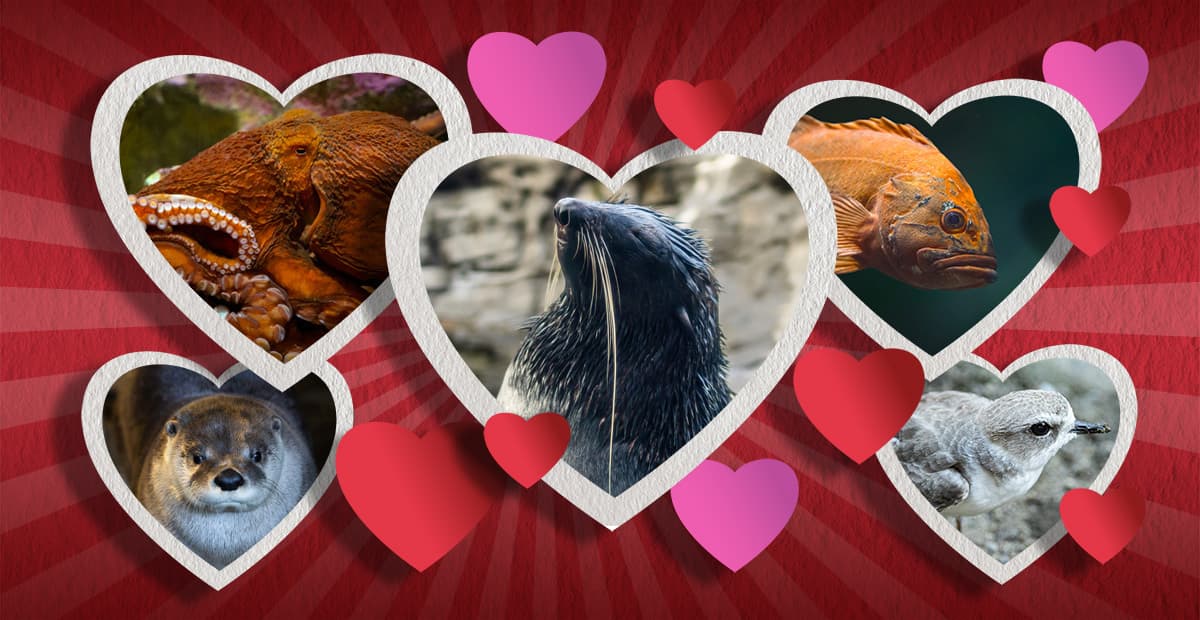
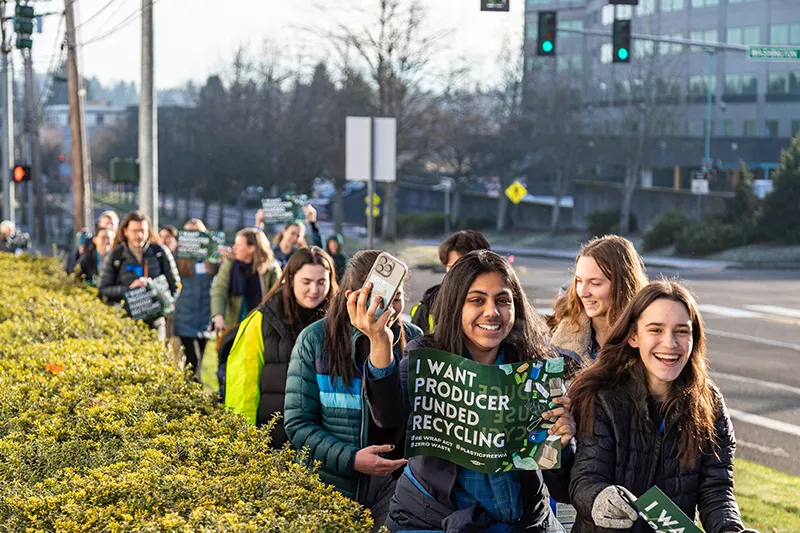
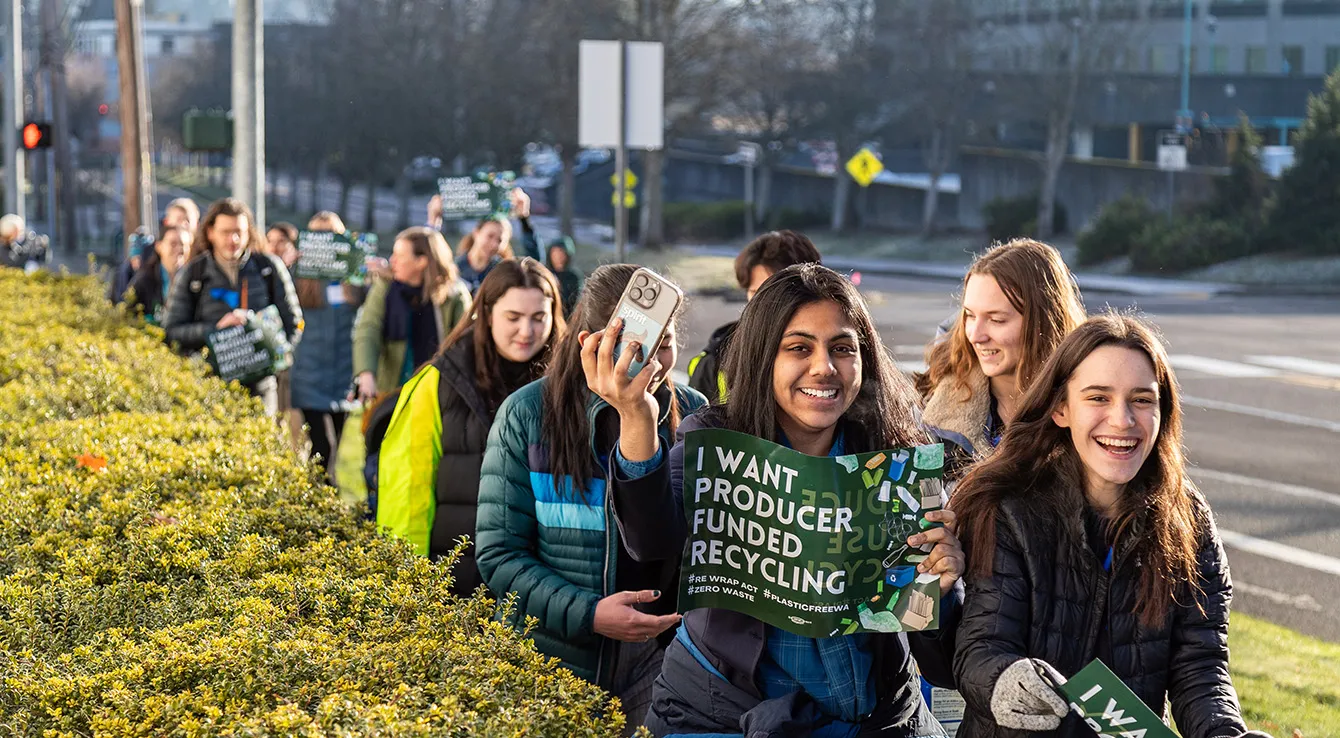
On January 15, our Youth Ocean Advocates (YOA) traveled to Olympia to show their support for the ReWRAP Act by participating in a constituent lobby day. The Seattle Aquarium collaborated with our Plastic Free Washington Coalition partners to gather nearly 100 Washingtonians to discuss with legislators how this bill will reduce waste and marine plastic pollution by transforming our state’s recycling system.
The ReWRAP Act (HB 2049/SB 6005), sponsored by Rep. Liz Berry and Sen. Liz Lovelett, will comprehensively increase recycling rates, incentivize more sustainable packaging design and ensure that all Washingtonians have access to free curbside recycling. Packaging producers will be financially responsible for the end-of-life costs of their packaging, a policy that other states like Maine, Colorado, Oregon and California have already passed.
Having learned about the intricacies of the bill to prepare to speak with legislators, Ellen, a 17-year-old from West Seattle, believes the bill will “revolutionize recycling in Washington.” For her, “It seems like it will kind of restore hope in the whole initiative of recycling and ideally shift the burden of protecting the environment more to the corporations who are responsible for manufacturing those materials in the first place.”
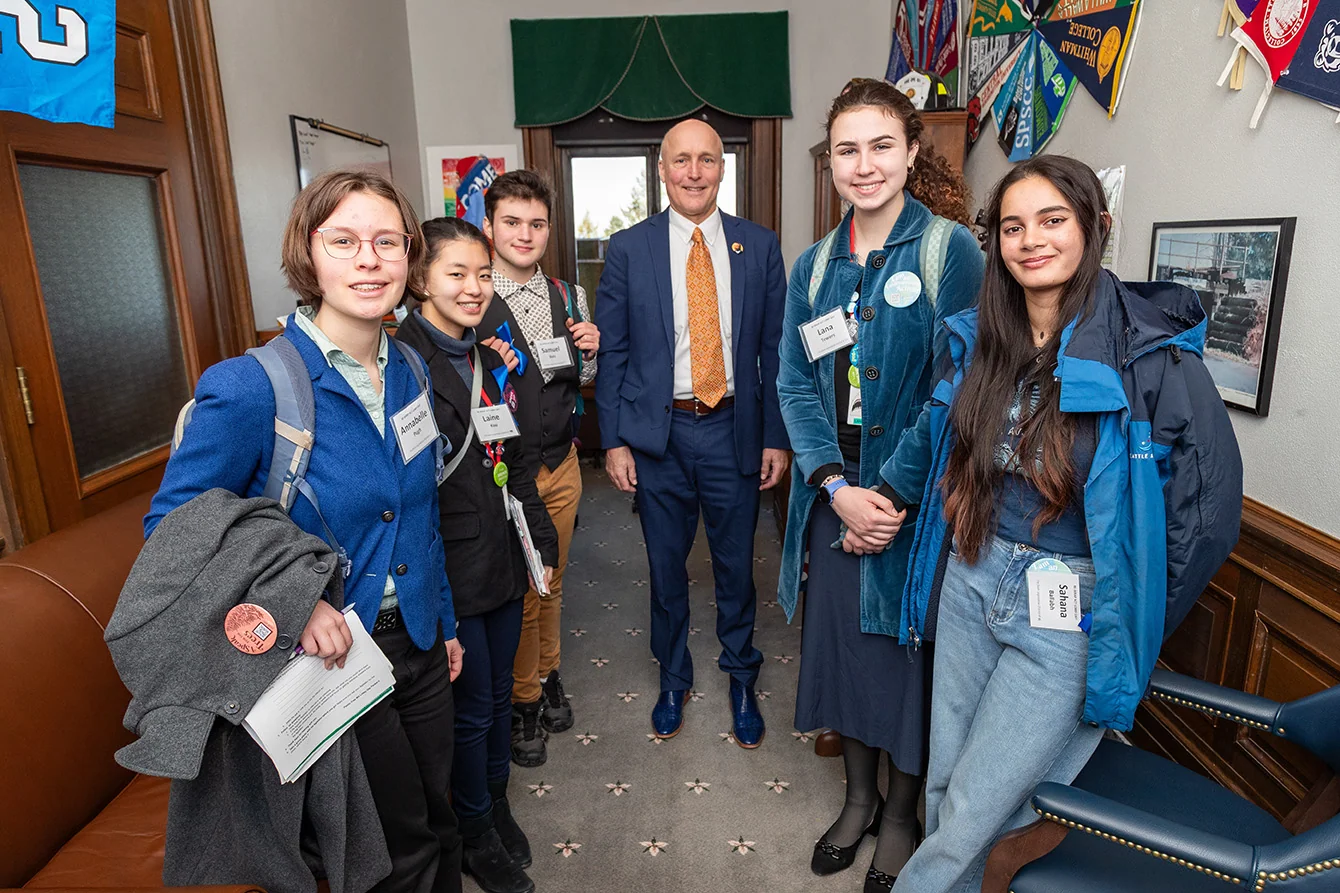
The lobby day volunteers organized over 70 meetings with state senators and representatives to encourage support for the ReWRAP Act. Together, 16 YOAs attended 12 meetings! Samuel, a 16-year-old from Redmond, found it “really empowering to be able to interact with the people who are helping put this legislation forward within our state and therefore be part of that process as well.”
In meetings with their legislators, YOAs spoke about their personal reasons for wanting ReWRAP to pass. Ellen went to Olympia to share with her legislators that she is “really passionate about ocean conservation and advocacy,” to contextualize how important this bill is to her. In her meetings, Cristina, a 17-year-old from Auburn, spoke about how this bill will make sure everyone has access to recycling services. She said, “A lot of the times in environmental policy, the focus can be put on the consumers when so much of pollution is coming from large corporations, so this really is taking pressure off the consumer or small businesses.”
Though meeting with a representative can seem intimidating, Annabelle, a junior who attends a high school in Seattle, found that “legislators want to hear from you.” She wanted to encourage others to “just be confident in yourself and use your power as a Washington resident.”
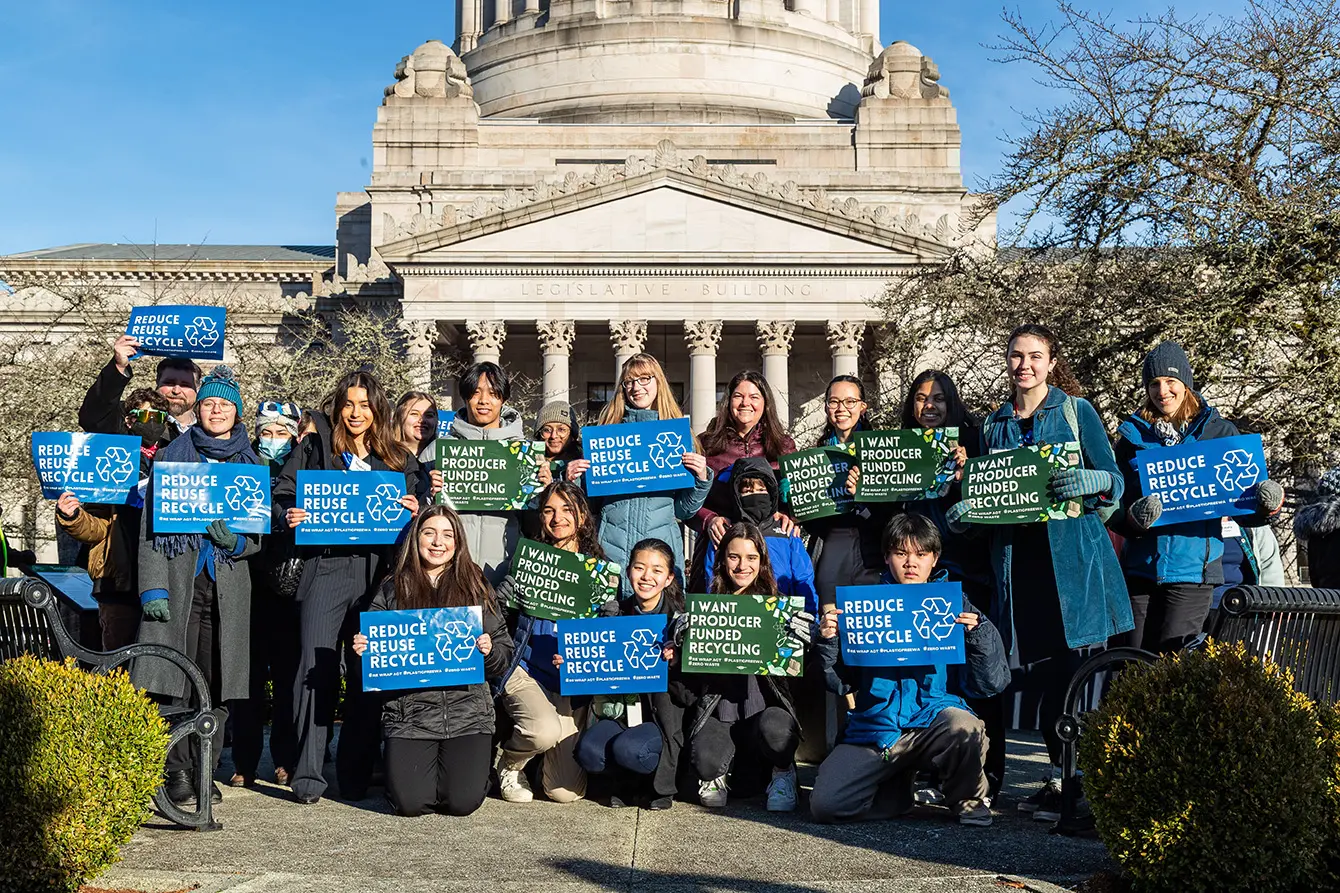
After marching across the Washington State Capitol Campus in nearly freezing temperatures, our YOAs and other lobby day participants got to hear from Rep. Berry, an environmental champion who has worked closely with many stakeholders, including the Aquarium, to advance this bill in the House. Representative Berry underscored the importance of youth engagement in policy. Lac, age 15, came away from the day feeling that “what you do does matter in terms of ocean pollution and (young people) are the future of our society.”
The YOAs also attended a House Education Committee hearing, where they got to listen to other young advocates testify on bills related to middle and high school curricula. Claire, a high school senior from Seattle, found it inspiring to hear other kids testify in that hearing “getting to see younger generations involved in this sort of thing is really important and just very exciting to see.”
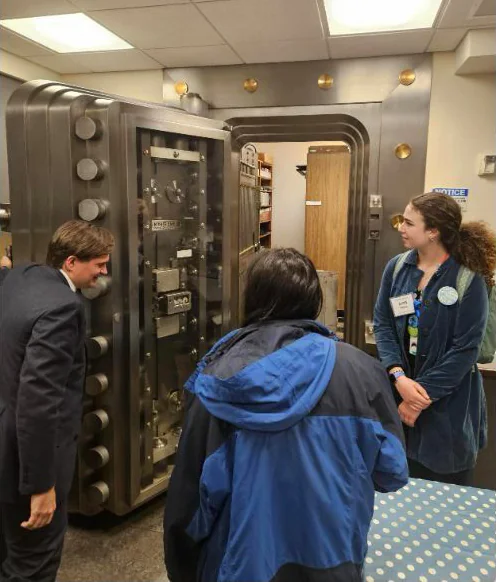
The YOAs also met with Washington State Treasurer Mike Pellicciotti and had a chance to check out the state vault. Sonia, a 17-year-old from Seattle, learned that “there are many different ways to become involved in politics, whether that’s being a treasurer or being a legislator or attending hearings…there are different ways to advocate your message.”
During the Lobby Day lunch speaker series, Athena Burk Bravo, a former Seattle Aquarium YOA, exemplified the different ways young people can reduce plastic pollution. Athena spoke to all the lobby day participants about her work founding a nonprofit called Trash Talk, which educates King County residents about the impact of recycling and pollution.
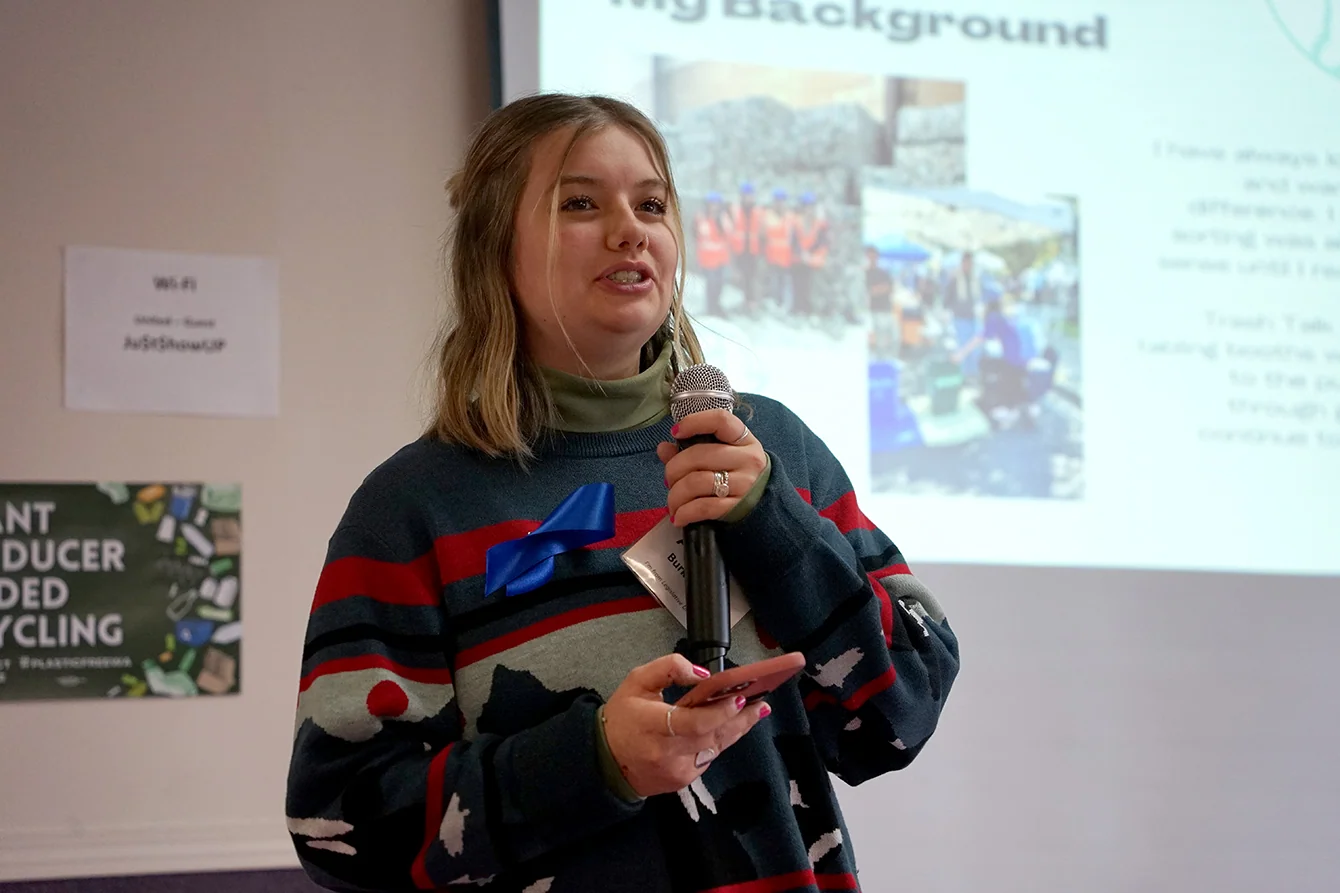
At the end of the day, Nikki, a 16-year-old YOA from Sammamish, said, “It was just so inspiring being in a big group of people, all really passionate about the same cause. And that really gets me excited to maybe attend more events like this and keep looking into what goes on with the ReWRAP Act.”
Recruitment for the new cohort of Seattle Aquarium Youth Ocean Advocates begins with orientation sessions in March. If you or a high schooler you know wants to participate in advocacy opportunities like this, you can go to the YOA webpage for more information. In the meantime, check out the rest of our 2024 State Legislative Priorities and stay up to date on the ReWRAP Act and other action opportunities by signing up for our policy action alerts!
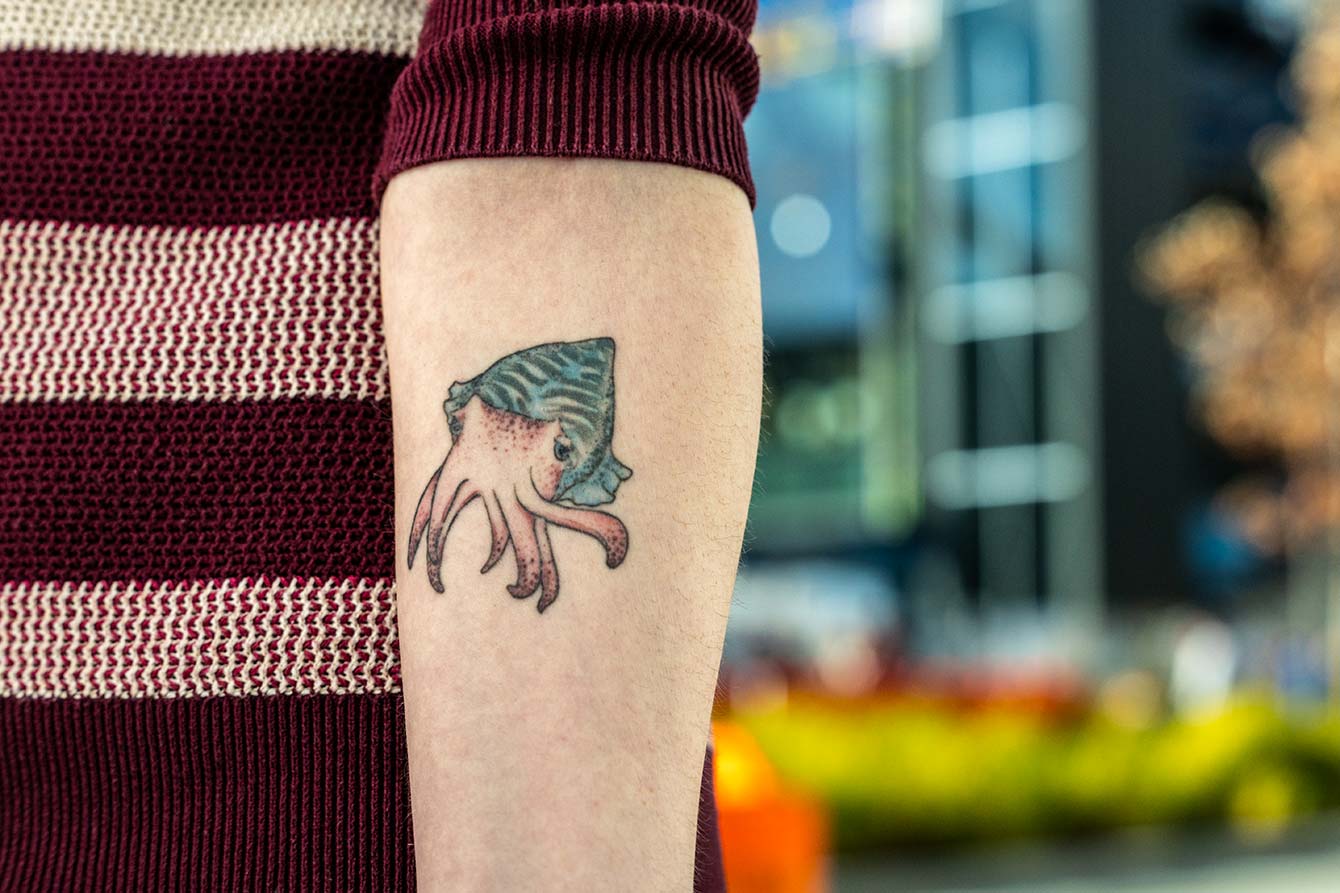
A few weeks ago, we introduced you to some of the many Seattle Aquarium team members who are so passionate about the marine environment that they’ve gotten tattoos representing the animals nearest and dearest to their hearts.
Now we’re back with our second installment—featuring a group of five outstanding individuals who met with us to share their tattoos and the inspiration behind them. We hope you enjoy getting to know these folks and reading the stories behind their ink!
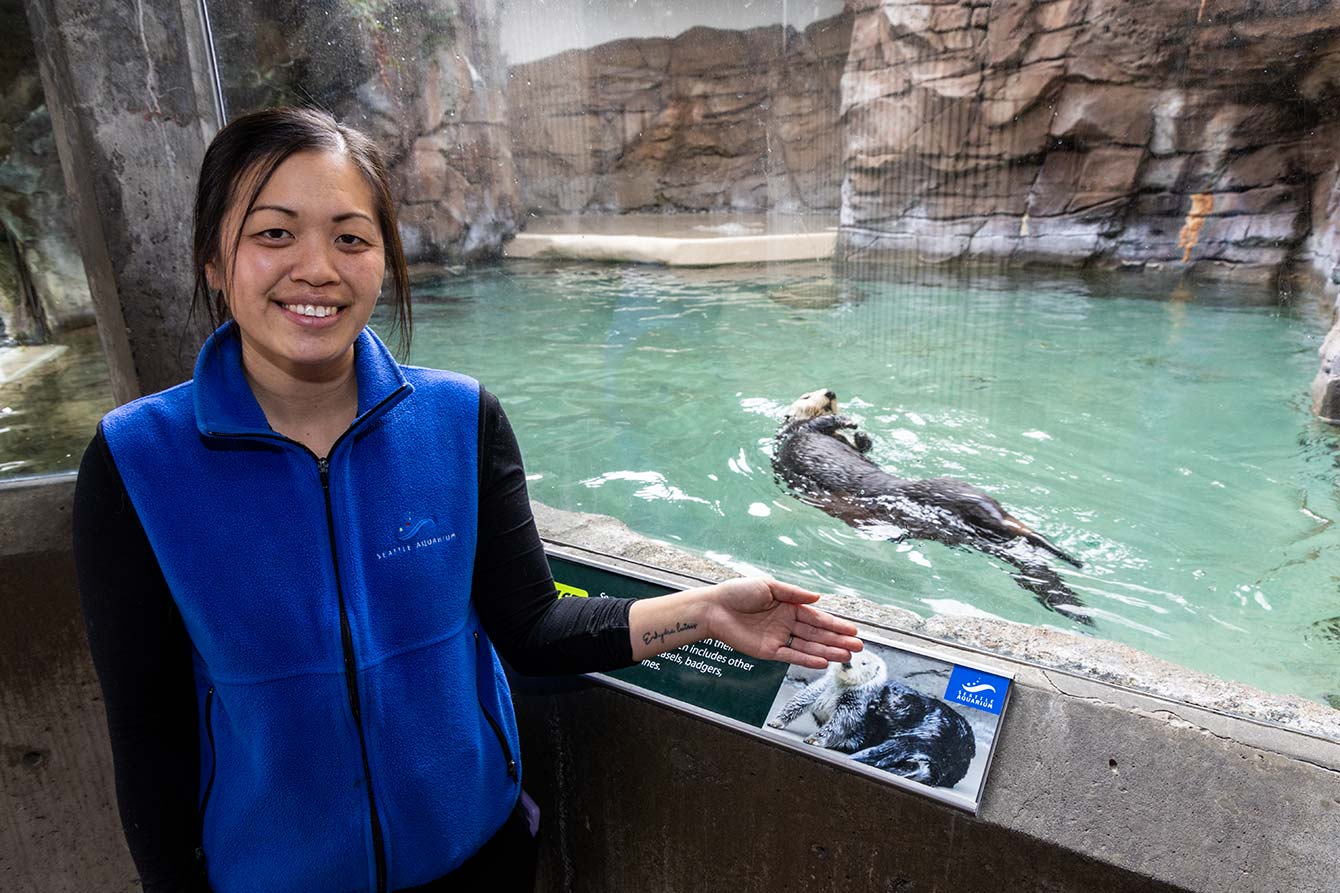
“My tattoo is the scientific name for sea otters: Enhydra lutris. They got me into this field of work that I love, and I wouldn't want to be doing anything else.”
—Kelli Lee (she/her), animal care specialist
“This is going to sound silly but, growing up, I enjoyed watching a show called The OC. In the last season, my favorite character started advocating for southern sea otters, which are found along the California coast.
I grew up in the Bay Area, more inland, so I didn’t have much exposure to marine mammals. When I first saw the show, I didn’t know exactly what a sea otter was. Obviously, I thought they were really cute—and then I started looking into them, how they’re a keystone species and how living so close to civilization has created challenges for them.
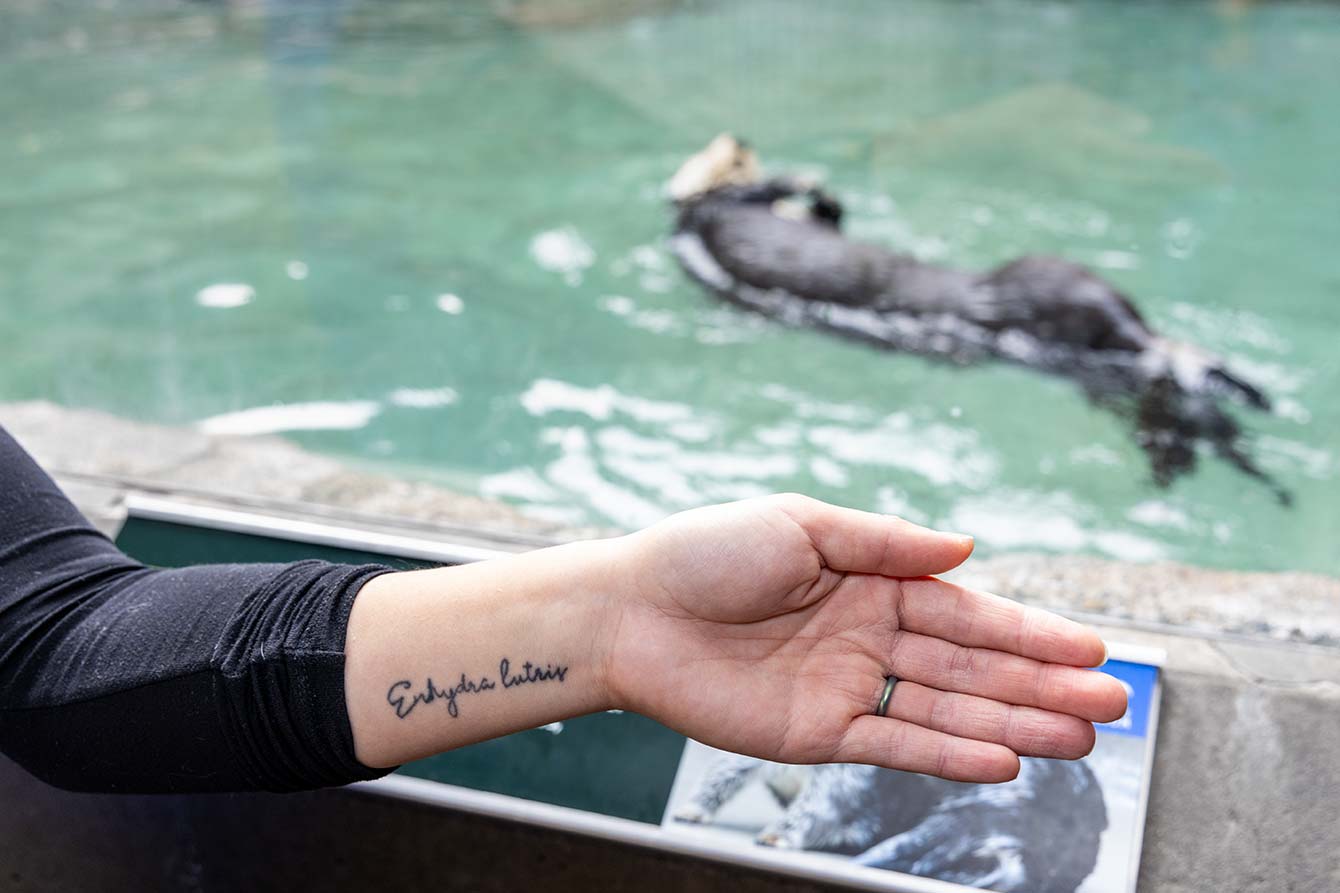
I pursued my first internship, at Point Defiance Zoo & Aquarium, because it was with sea otters. I wanted to get experience with them to see if I wanted to work with terrestrial or marine animals.
I loved them right away. But it was working with other species in that section of the zoo, like harbor seals and puffins, that made me really want to stay with this. So l have sea otters to thank for me getting into the aquarium field and specifically focusing on marine animals.
My favorite is training with the animals, especially new behaviors. You have to be thoughtful of what species you’re working with and the individual, because everybody is different, with their own ways and speeds of learning. It’s really cool.
Working with my team is also something that I really enjoy. We help each other through the ups and downs of work and our lives too. It’s great to have support like that at work.”
—Kelli Lee (she/her), animal care specialist
Tattoo by Kendal Tull-Esterbrook at Lilith Tattoo, Instagram @lub.dub.tattoo
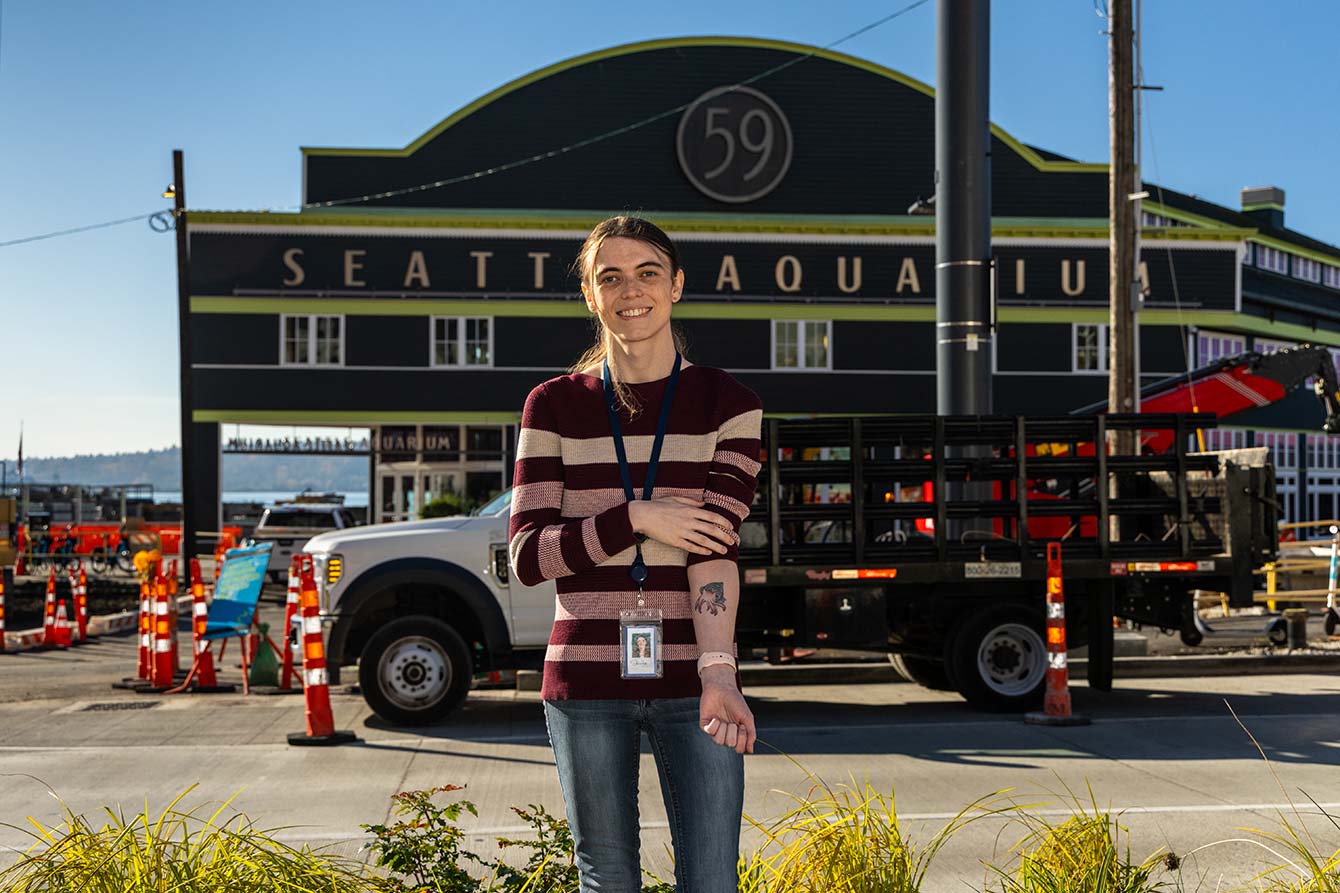
“A cuttlefish felt right: I had a job that I enjoyed in an organization that I appreciated during an important transition in my life. It all came together at the same time.”
—Jessica Williams (she/her), philanthropy data entry specialist
“I’ve always loved cephalopods. Anything in that group—I love it if it’s free-flowing and tentacle-y. I think they’re so graceful and magical. Especially cuttlefish. I love how they look like spaceships, the way they hover at a very specific angle. I can’t get enough of them.
I moved to Seattle looking for a clean slate. You may notice that my tattoo has the colors of the transgender flag. I moved here because I’m trans and this is a wonderful place to transition. I have family up here. Everything came together: Seattle was the place for me to go next.
I was floating, not sure what I wanted to do, but I knew the kind of mission I wanted to serve, the kind of place and people I wanted to be around. For me, that’s the Seattle Aquarium. I love my team. It’s such a good group and I’m happy to work with people I’m so frequently in awe of.

I like that the Aquarium is trying to change the conversation around animals that people don’t necessarily have a lot of empathy for. I love the concept of not lower intelligence, but different intelligence—and that we have the opportunity to widen people’s idea of what animal intelligence is.
I also think the Aquarium is elevating the conversation that a lot of people living next to a body of water are having: ‘This is valuable. We need to save it.’ It’s not just us working here who care—there’s a community of people around us who want to see this place succeed and help the marine environment thrive.”
—Jessica Williams (she/her), philanthropy data entry specialist
Tattoo by Grace Peters at Grace Does Tattoos, Instagram @gracedoestattoos
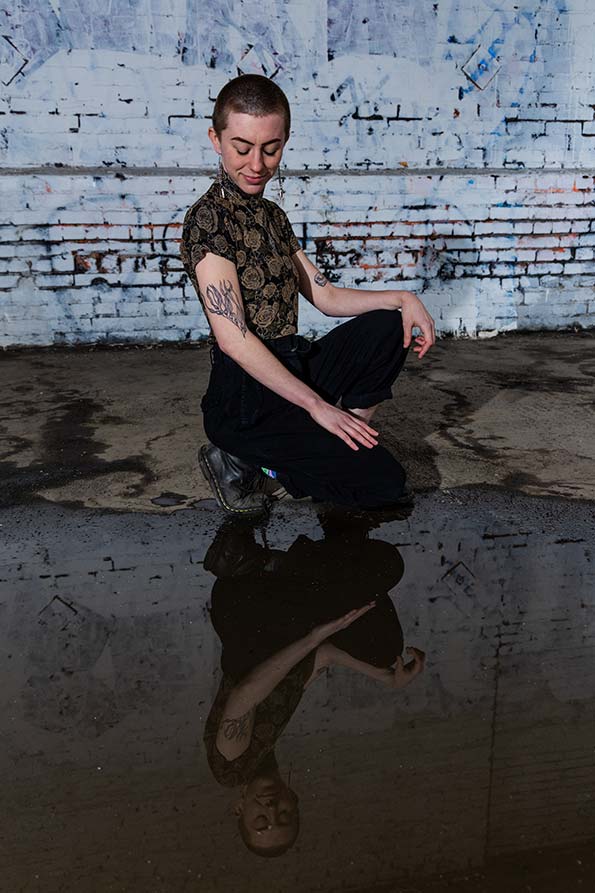
“It reignited that passion in me: ‘Here’s an opportunity where I can actually make a difference and see that difference in the world.’ ”
—Emma Leiser (she/they), web intern
“I got my kelp tattoo because I’ve always felt strongly about our ocean and environment and wanted a little something on my body to represent that. I love that kelp is such a vital part of so many different ecosystems. It’s shelter, it’s food…it’s a beautiful resource for so many different creatures, and I just think that’s super neat.
I was a very science-driven kid. In high school, I took a marine biology class, which was really cool because I was at a small, rural, poor school—we didn’t even have a physics class. But we had an amazing teacher with a degree in marine ecology. She had a full roster but was so passionate that she wanted to teach marine biology too. That was an incredible experience for me as a young kid in inland California, three hours from the coast.
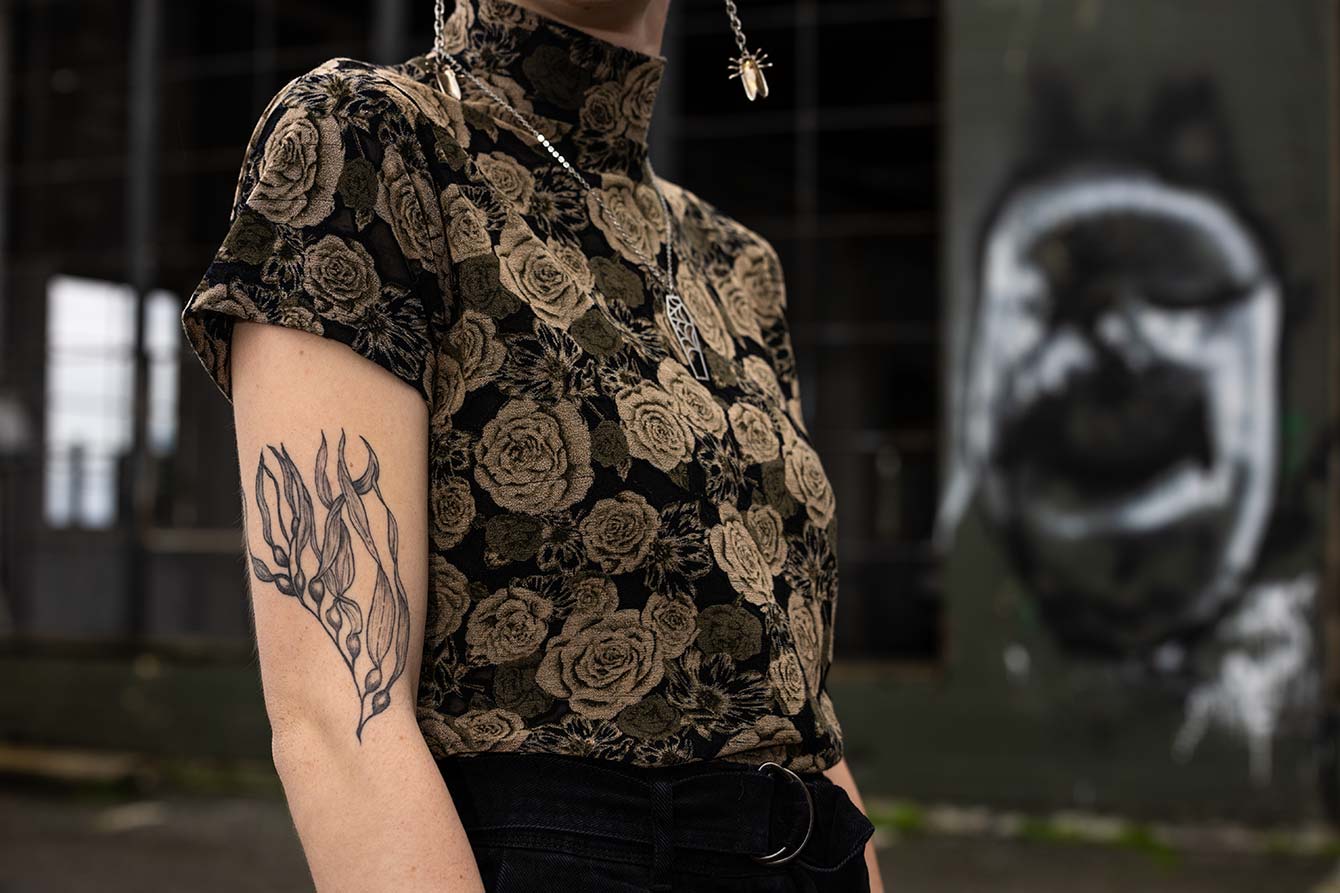
Growing up, we never really went on vacations but we did go tide pooling occasionally, and that was—oh my gosh, so magical. That’s why I love that the Aquarium has programs like the Beach Naturalist program. Just giving kids and families opportunities to explore what’s in their local environment. It’s one thing to read and learn about it, and it’s entirely different to actually experience it and make that connection with your local waters and all the creatures living there.
I saw the opening here at the Aquarium and got so excited because I love the work that’s being done here—and I didn’t even know about half of it yet. I just really desperately wanted to work somewhere that was actually fighting to make a difference.”
—Emma Leiser (she/they), web intern
Tattoo by Callie Little at Good Habits Tattoo, Instagram @goshcallie
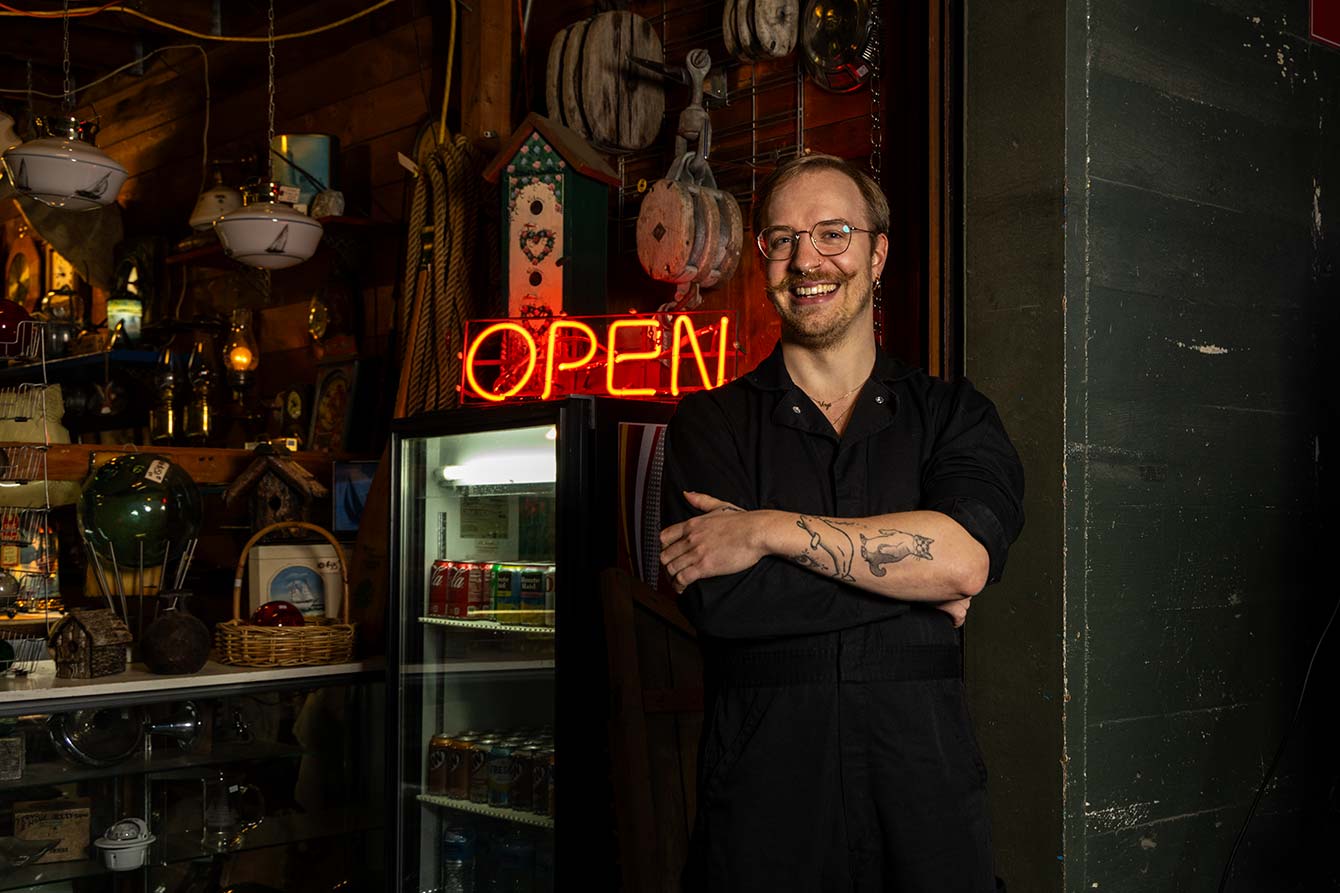
“I've always had a passion for marine life, but didn't always have a lot of opportunities to experience it, growing up in Minnesota. Little bits of my history and my love of animals carried me to the point of wanting to get a beluga whale tattoo.”
—Ben Swenson-Klatt (they/them), annual fund officer
“I have a particular affinity for beluga whales, which goes all the way back to my early childhood. My parents would read the book Baby Beluga to me and I had the joy of getting to see them at the Shedd Aquarium when I was young. My parents like to joke that I broke down in tears because I was so excited to see them. I’ve always just loved them so much.
I have a tattoo artist friend and pitched the idea of a beluga whale wearing a hat. My fun story is that I had already booked the appointment when I was in the process of interviewing, and I got the tattoo on the day that the Aquarium offered me the annual fund officer job. It definitely felt like a wonderful coincidence.
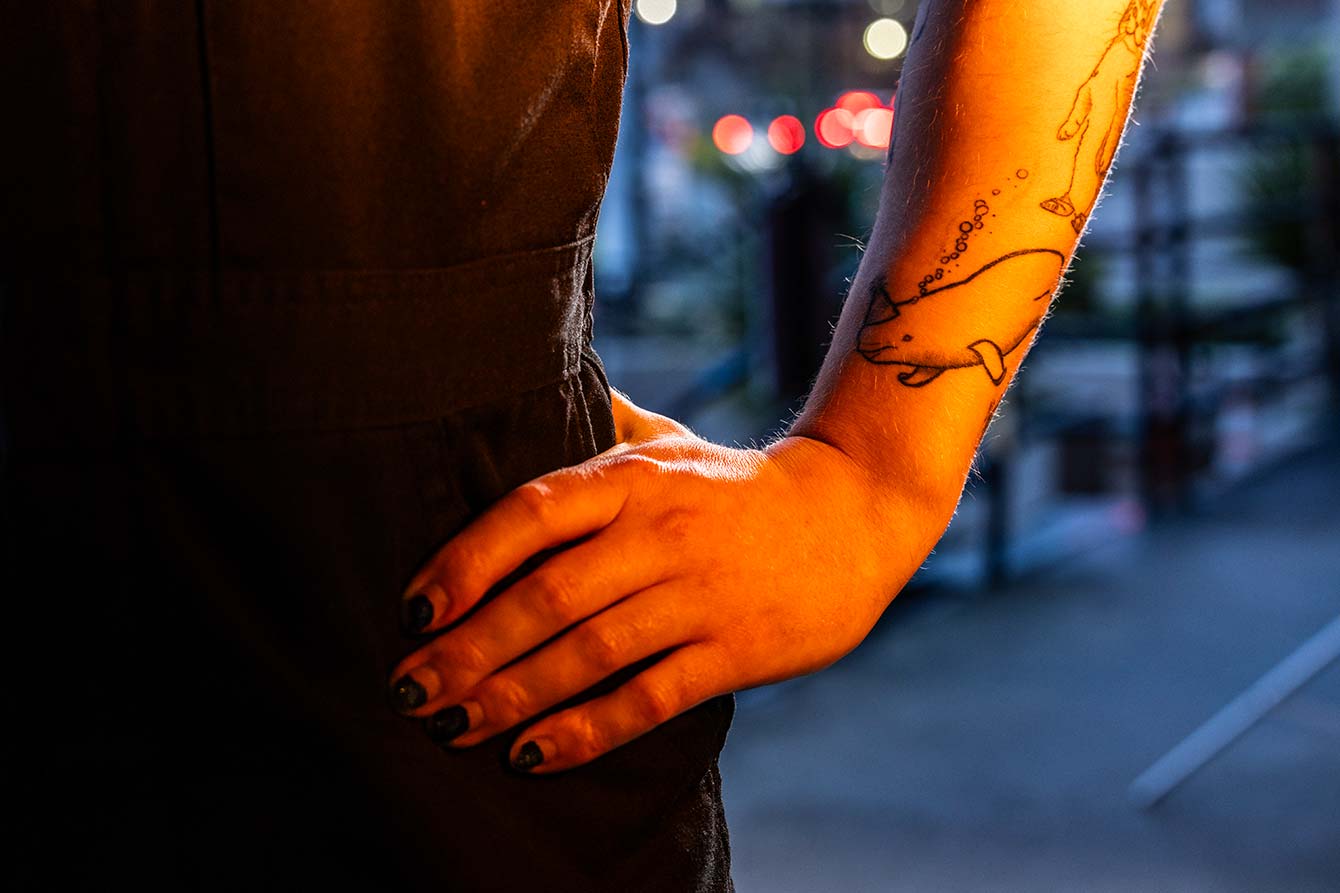
I fully believe that there is no action too small to take to protect our environment and, obviously, things like recycling make a big difference. But putting your money where it matters, I think, is a really important thing. Even something small really can make a big difference.
I look at fundraising as a way to organize collective care around things that are important to a community. And, for me particularly, I think that something that’s really inspiring about the Aquarium is that there’s this care in the Seattle community for our environment. We’re blessed to live so close to these incredible natural features. Having an organization that’s on Puget Sound and taking care of it—I think that’s a really important thing for the city to believe in.”
—Ben Swenson-Klatt (they/them), annual fund officer
Tattoo by Gabby Clarke, Instagram @_honeydewd_
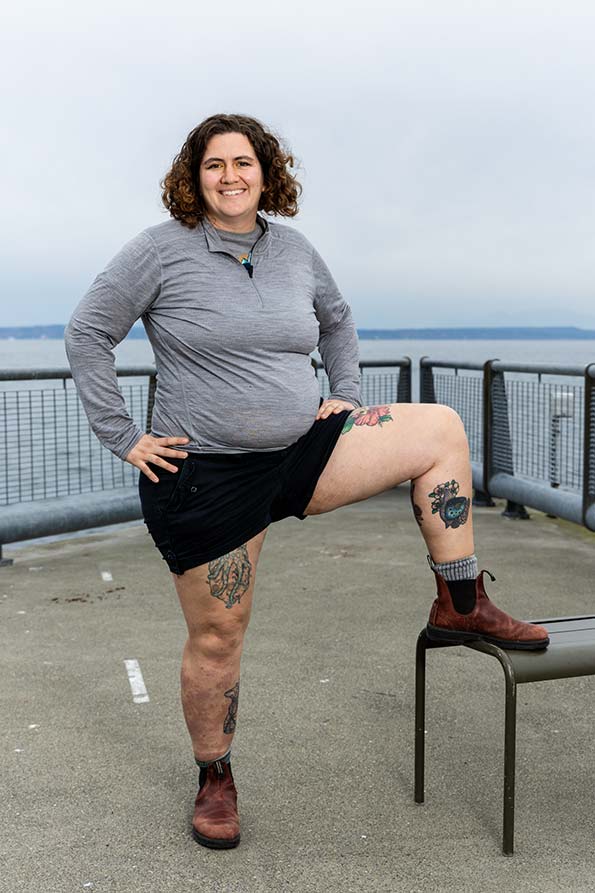
“Sunfish are such cool, unique animals. I think it's inspiring that they start as itty-bitty plankton and grow into the heaviest bony fish in the ocean.”
—Kaitlin Brawley (she/her), aquarist
“The reason I get tattoos is mostly to mark new chapters in my life and commemorate things that are important to me. In some cases they celebrate new jobs, places and experiences; others helped me find closure from loss or big life transitions. Whatever the reason, they always end up being very special to me.
The sunfish was one I had wanted for a while. To me, sunfish represent big things growing from small things. And they truly embody the ‘just keep swimming’ mentality, so they’re special to me in that way. I moved around a lot as a kid because my dad was military, so I’ve done a lot of starting small and just swimming until I get things figured out. Bigger things come from that.
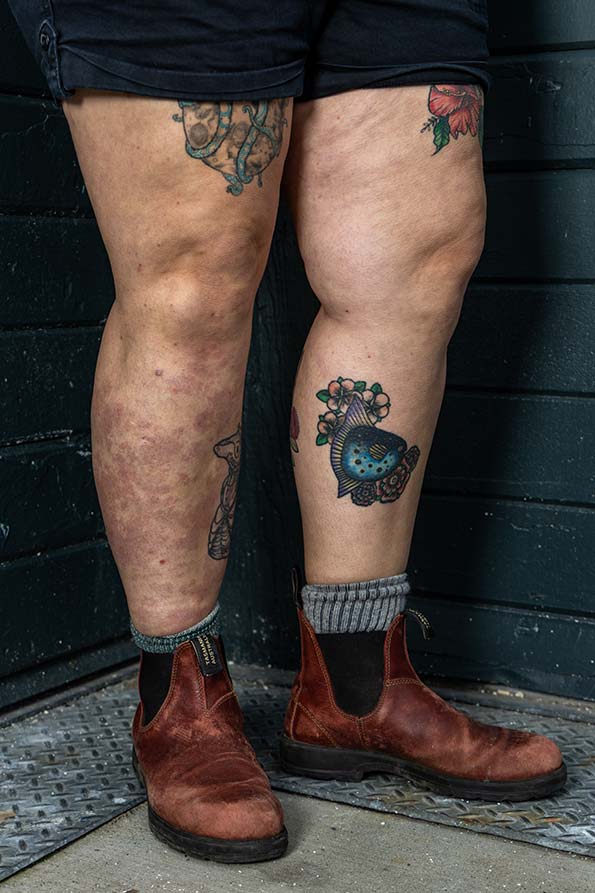
I wasn’t diagnosed with ADHD until I was 20. So I had a learning disability that impacted my grades and ability to study, to the point where I almost had to drop out of college. Then, after I got diagnosed and figured some things out, I got my life rolling on a better track. I ended up doing an internship with Monterey Bay Aquarium and moved to Hawai‘i to pursue diving and then, finally, the job here.
I think aquariums play an important role in connecting people to nature and getting them to care about it. Being part of that mission is something I really appreciate. Anytime I talk to someone and they say, ‘Oh, we love going to the Seattle Aquarium,’ it makes me happy to be part of that.”
—Kaitlin Brawley (she/her), aquarist
Tattoo by Anthony Bending at Lady Luck Tattoo, Instagram @ladylucktattoohawaii
Interested in joining the people featured in our web story with a job at the Seattle Aquarium? No tattoos required! Visit our careers page to see our latest open roles.
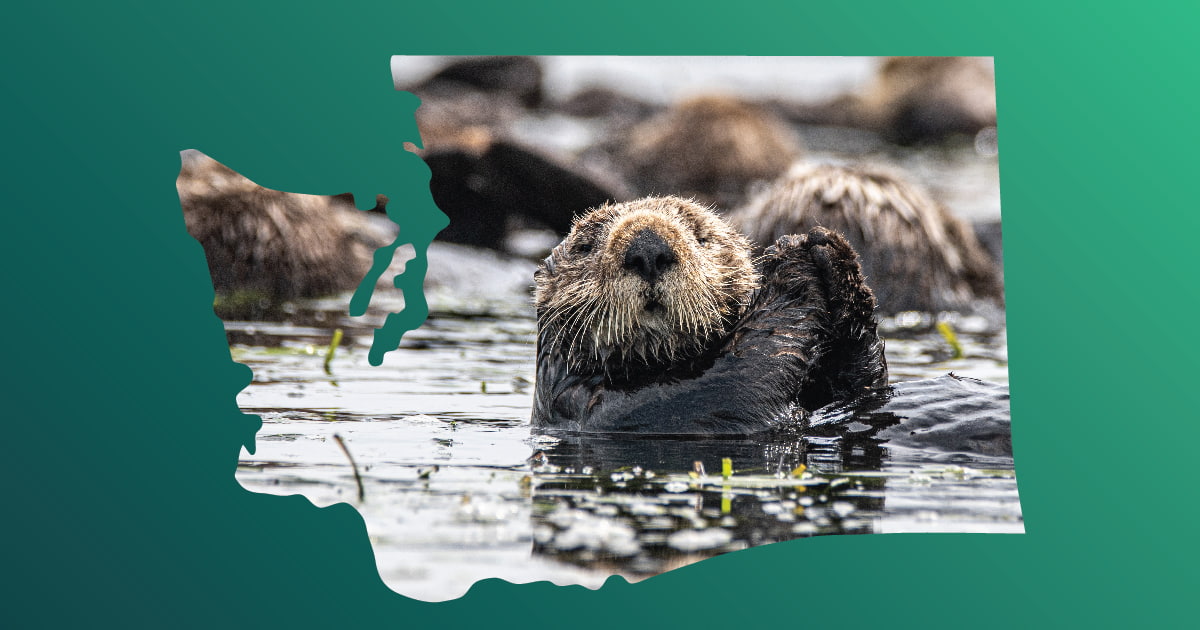
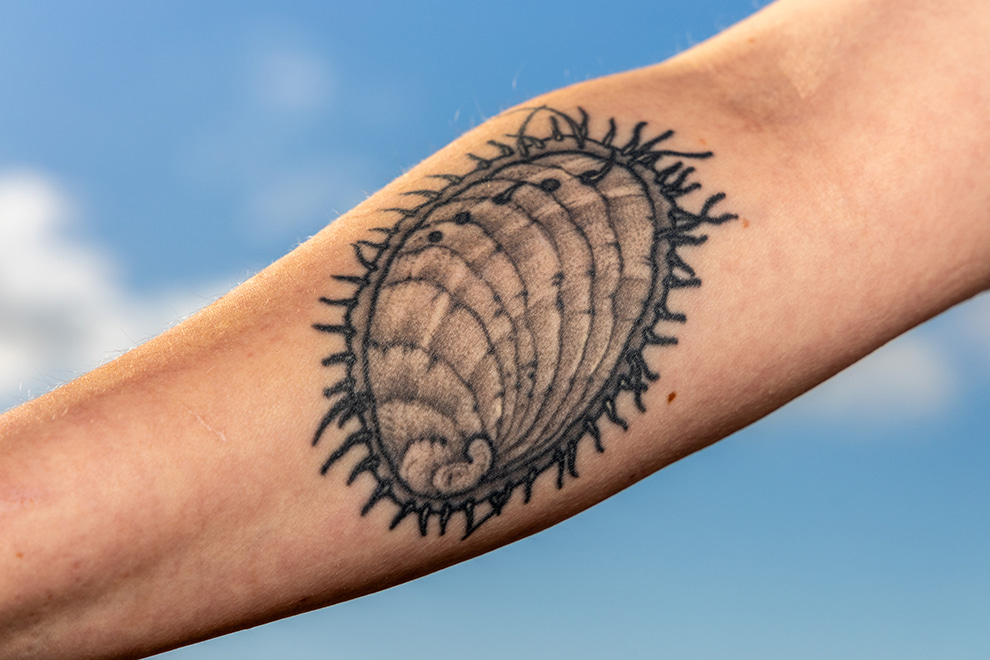
When we say that some Seattle Aquarium team members wear their love for the marine environment on their sleeves, we mean it literally. And it doesn’t stop there! As it turns out, a good number of Aquarium staff members show their love for the ocean and its inhabitants with some pretty incredible tattoos—on sleeves, arms, legs and more.
In fact, when we put out a call for people who would be interested in sharing their tattoos—and the inspiration behind them—in a web story, the response was so strong that a series was clearly in order.
Here we bring you “Tattoos of the Seattle Aquarium, Part 1.” We hope you enjoy getting to know these four folks and discovering the stories behind their ink!
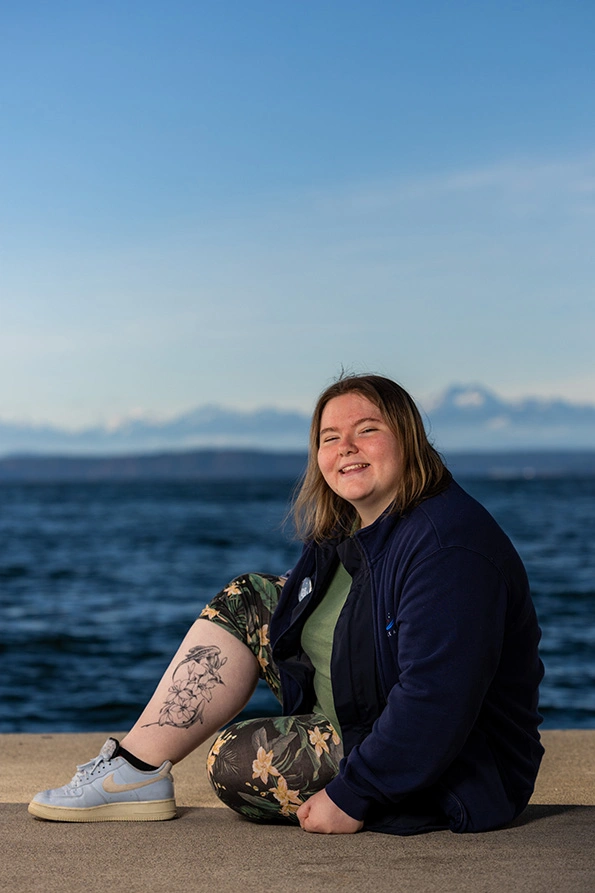
"I’ve always liked the parallel of flowers and sharks: something that's so stereotypically beautiful and something that's portrayed so poorly in media."
—Alijah Benbrook (she/they), youth engagement mentor
“I like to talk about how hippos statistically kill more people than sharks do, and that you’re more likely to get struck by lightning twice in your lifetime than you are to get attacked by a shark. Stats like that can help people think about it in perspective.
The top of my tattoo is an Indo-Pacific leopard shark, which actually fits nicely because that’s the species that the Aquarium is helping to restore. The bottom is a blacktip reef shark, my favorite species of shark and the first larger species I ever saw in real life, when I was 11. And then my favorite flower: white lilies. Whenever I see them, I think of my mom. She had them around the house all the time when I was growing up. She was a single mom, so we’re very close.
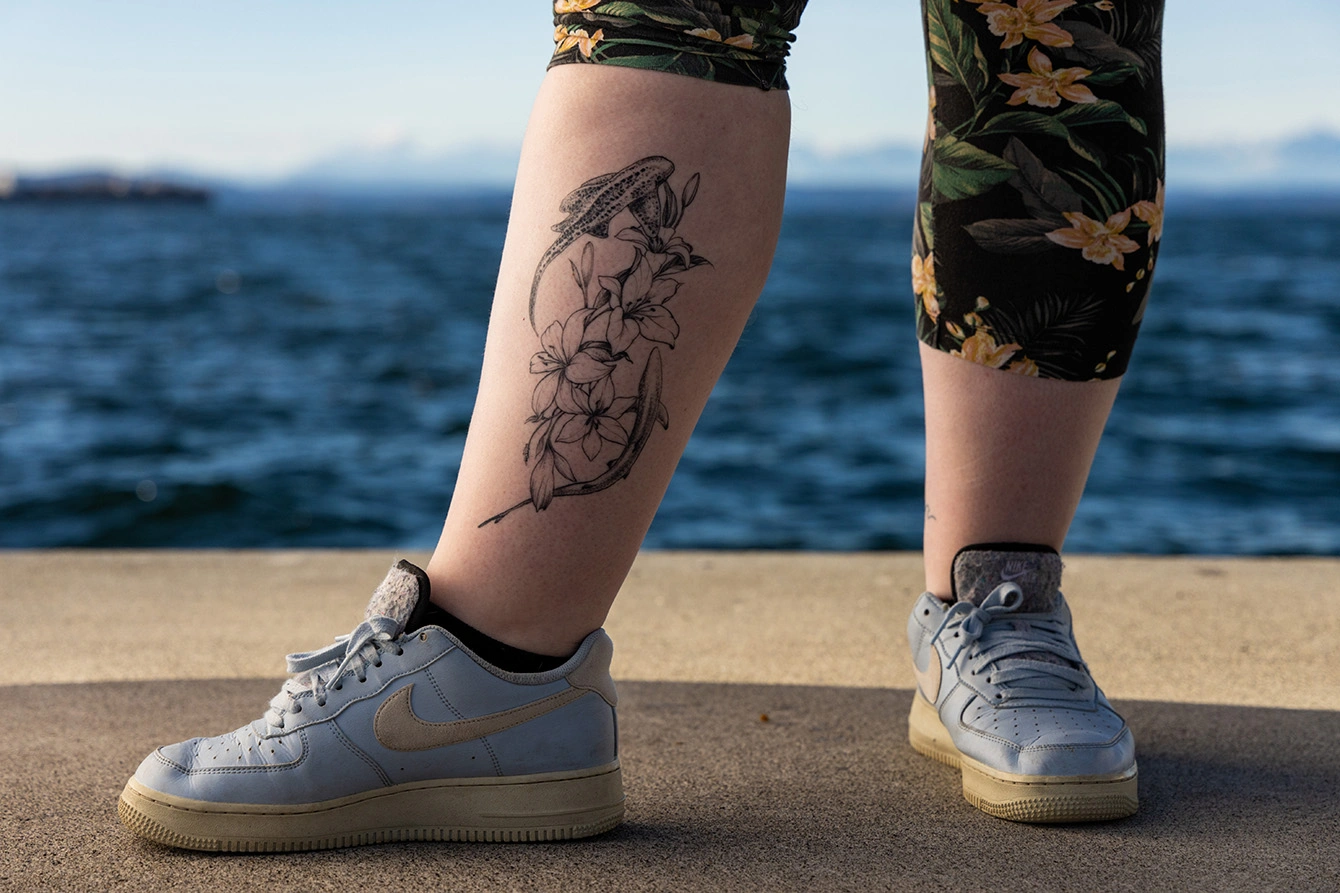
I’ve had a fun path with the Aquarium. I was 5 the first time I did marine summer camp. I came every summer until I was too old, then I joined the Youth Ocean Advocates program, became an adult volunteer, worked in the gift shop—and now I’m on staff.
I think doing those youth development programs really shifted my gears because, when I was little, the one obvious pathway for a career in marine science was research. The Aquarium’s youth programs showed me that other paths were possible and brought me out of my shell. It feels very full circle because I wouldn’t be who I am without that type of mentorship—and it feels really good to give that mentorship to other kids.”
—Alijah Benbrook (she/they), youth engagement mentor
Tattoo by Zezi at Finer Things Tattoo, Instagram @zezitattoo
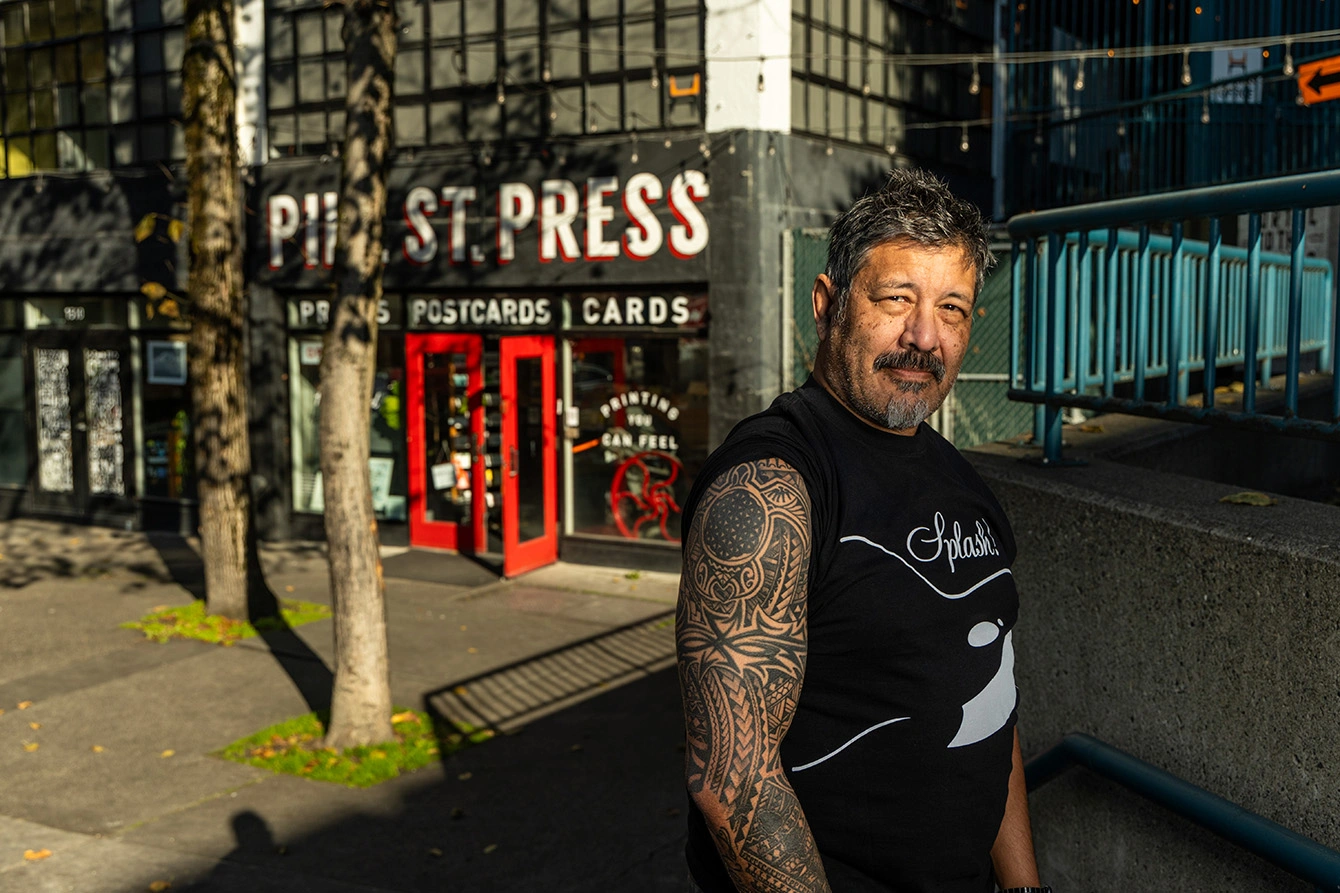
"I love the ocean. It’s so unimaginably huge and powerful, with this sense of peacefulness about it. There's something about it that—it’s funny, it’s the opposite word—is so grounding."
—Mike Strassburger (he/him), senior graphic designer
“When my wife and I travel, the ocean is almost always involved. We went to the Big Island a few years back and I felt extra connected to Hawai‘i and my family there. For the first time, it felt like another home.
I’d been thinking for a long time about a sleeve tattoo and after that trip, it all just kind of came together. My wife and I had been going through really tough times with our youngest kiddo, who we almost lost. So the seed of life symbol inside the sea turtle has a lot of meaning. And the turtle itself was an easy choice because they’re amazing, peaceful, beautiful creatures. A great conduit for me to appreciate life and my roots in Hawai‘i.
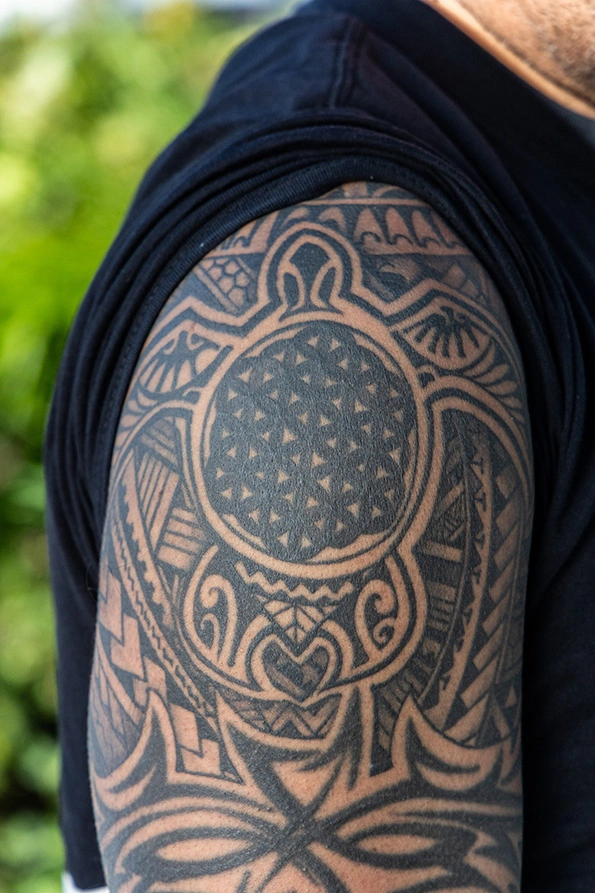
If I go snorkeling and see one, it feels extremely personal. You’re underwater, you feel completely alone and there’s a sense of, ‘It’s only me here. I can’t talk to anybody. I don’t see or hear anybody. I’m just in this space…and with me is this turtle.’ You can’t help but feel a super special connection, being in such a private zone and experiencing it with a turtle.
Feeling a sense of connection is a big driver for me. My job at the Aquarium is trying to help make the best possible experience for our guests through graphic design—and even if I’m just creating artwork on a computer, I know it’s connected to something larger. We have a mission and people are furthering it from every level. I like being a contributor to that.”
—Mike Strassburger (he/him), senior graphic designer
Tattoo by Mua Posala at Paka Polynesian Tattoo, Instagram @paka_polynesian
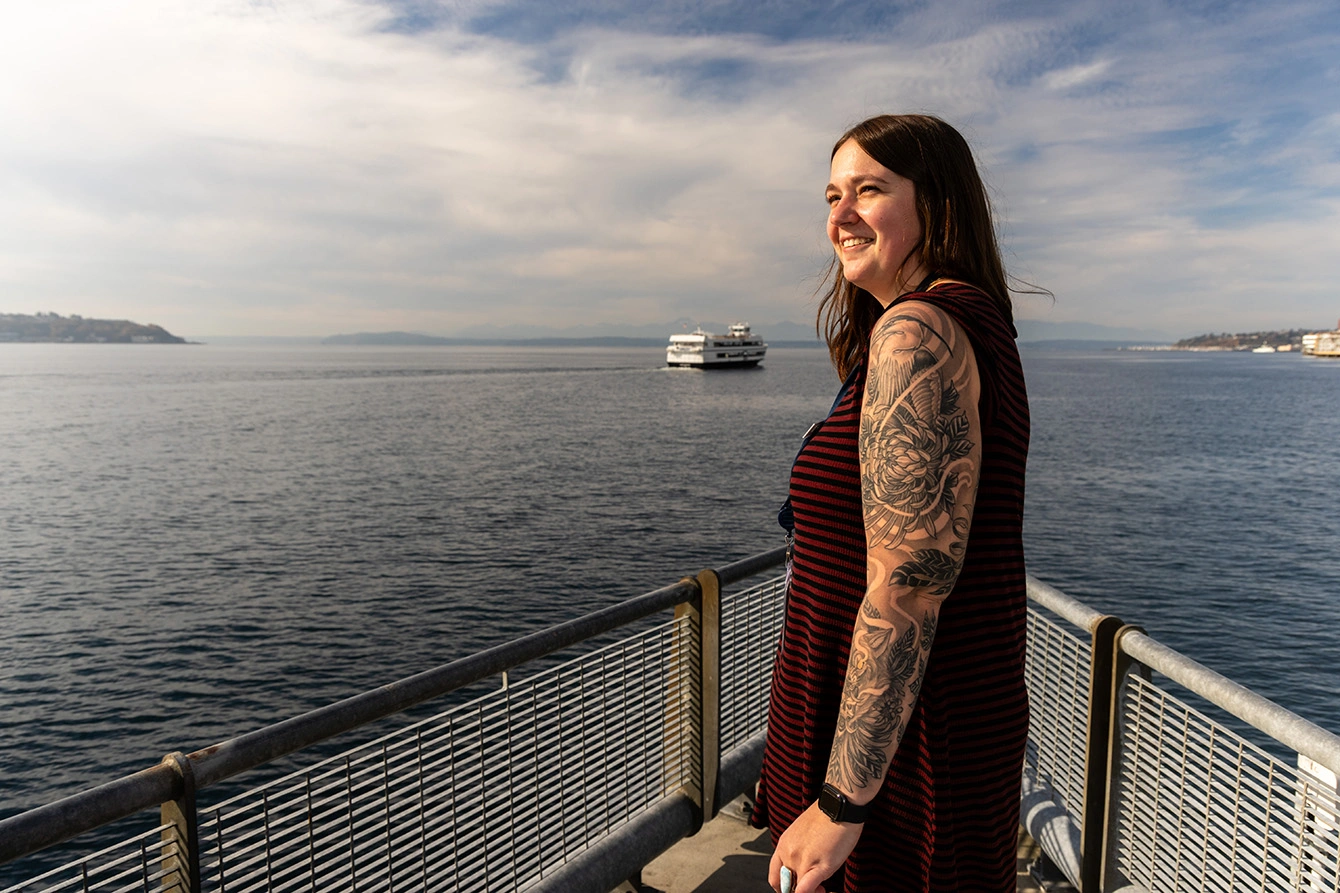
"I think great blue herons are really graceful, very cool birds. They're also kind of awkward and dorky, and I like that too."
—Shelby Kremenich (she/her), government relations coordinator, 2022–2023
“I studied environmental education at Western, up in Bellingham. Some of the lessons I did were about great blue herons and eelgrass, and how important they are in the marine environment. I especially liked learning about herons. There’s a rookery in Bellingham and I visited it a lot. So a heron felt like a natural choice for my first tattoo.
I was quite an activist in college, did a lot of protests. I got involved in the political community through that—especially the environmental political community—and got connected through folks I knew. Someone reached out to me near the end of my college program said, ‘Hey, we need a campaign manager for this person, do you want to do it?’ I did, and it ended up leading me to where I am now.
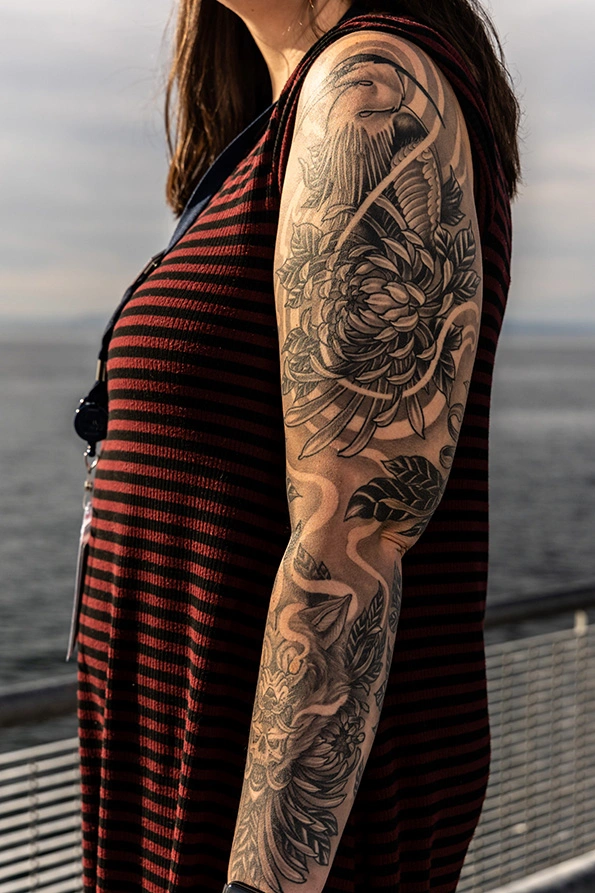
After I graduated in 2017, I ran campaigns in Whatcom County for three years. I worked on a state senate race where the candidate lost by just 48 votes—seriously. I’ve also worked for Congresswoman DelBene, Governor Jay Inslee and Senator Patty Murray. Politics is fun. It’s very fast-paced.
What I like about my work at the Aquarium is that it’s a fusion of politics—or, rather, government relations—and what I studied and enjoyed in college: environmental education and marine science. I think of the government relations team as a funding force, helping to fund the Aquarium’s conservation work through government resources. We also maintain relationships with elected officials to help make sure the Aquarium can keep growing its impact.”
—Shelby Kremenich (she/her), government relations coordinator, 2022–2023
Tattoo by Dani Wilson at Rabbit and Thorn Tattoo, Instagram @daniwilsonart
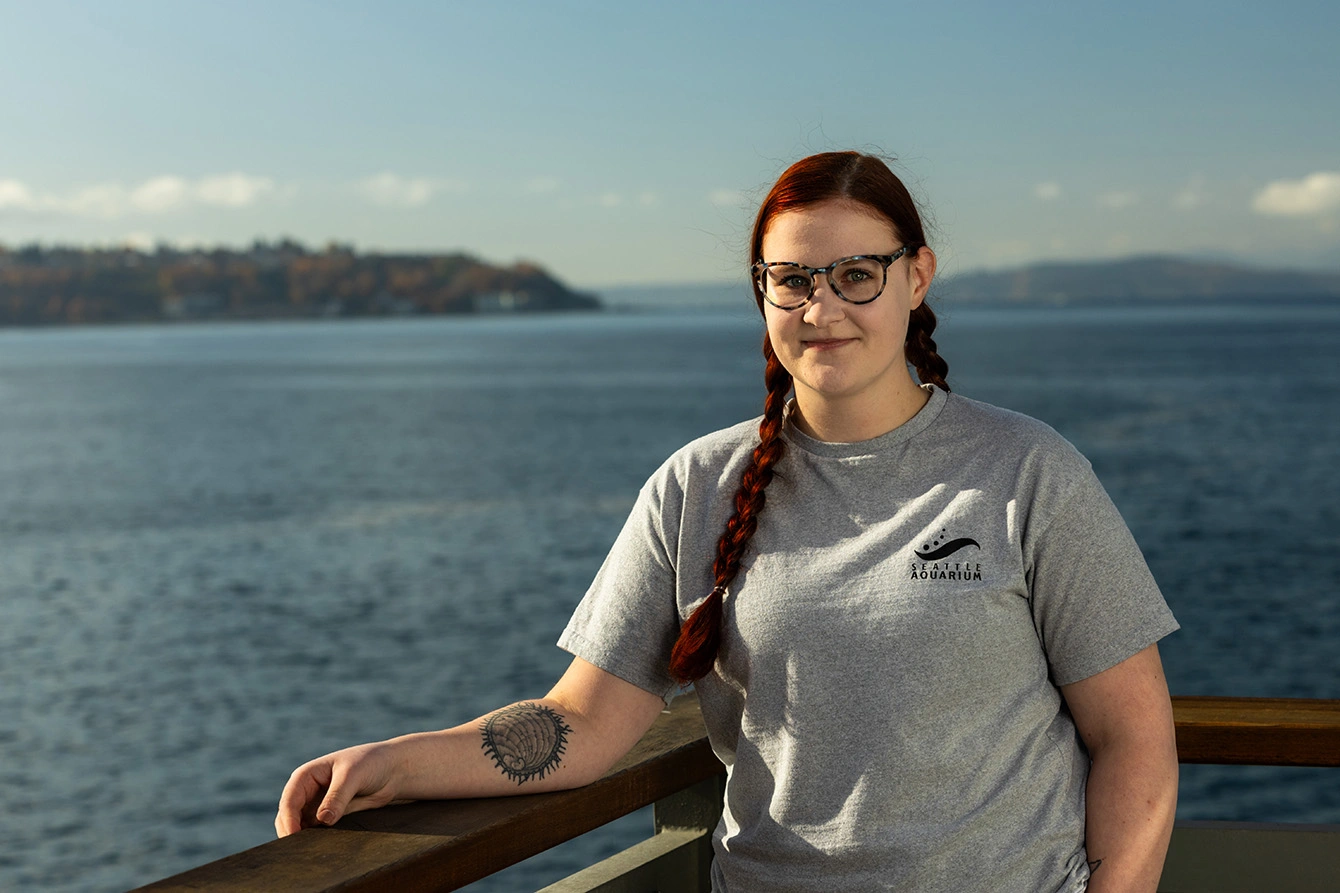
"If you talk about abalone, a lot of people will say, ‘Yum, delicious,’ but there's so much more to know."
—Bailey Johnson (she/her), aquarist
“I tell people how important they are for kelp forest health, and that they’re culturally significant to local tribes. That they used to be much more readily available in Puget Sound and now they’re not. And how we’re partnering to try to boost those numbers again.
I fell in love with pinto abalone when I was in college, working in a research lab. I thought they were excited to see me because when you give them kelp, they rear up and it’s the cutest little thing in the entire world. I was like, ‘These are my jam. I love them.’ So I decided to get a tattoo. My dad named him: Bill the ‘Balone, like baloney.
I also volunteered at the Aquarium during that time but it was when I did an internship here that I knew I’d found the thing I wanted to do. I was a temp for a while, got a relief position, then, earlier this year, there was an opening for a non-diving aquarist role. I’m not a diver—I have Type 1 diabetes and it’s hard enough being a diabetic on land. It was my dream job, and here I am.

The coolest part is that every day is different. You’re an aquarist, but you’re also a plumber or a life support technician, or coming up with a new design for a habitat. You have to be creative and artistic. I also like that we have our pinto abalone hatchery at the Animal Care Center now, and every other week I get to take care of them. I feel like I’m doing something important when I come to work, which is a really nice feeling.”
—Bailey Johnson (she/her), aquarist
Tattoo by Slave to the Needle, Instagram @slavetotheneedle
Interested in joining the people featured in our web story with a job at the Seattle Aquarium? No tattoos required! Visit our careers page to see our latest open roles.
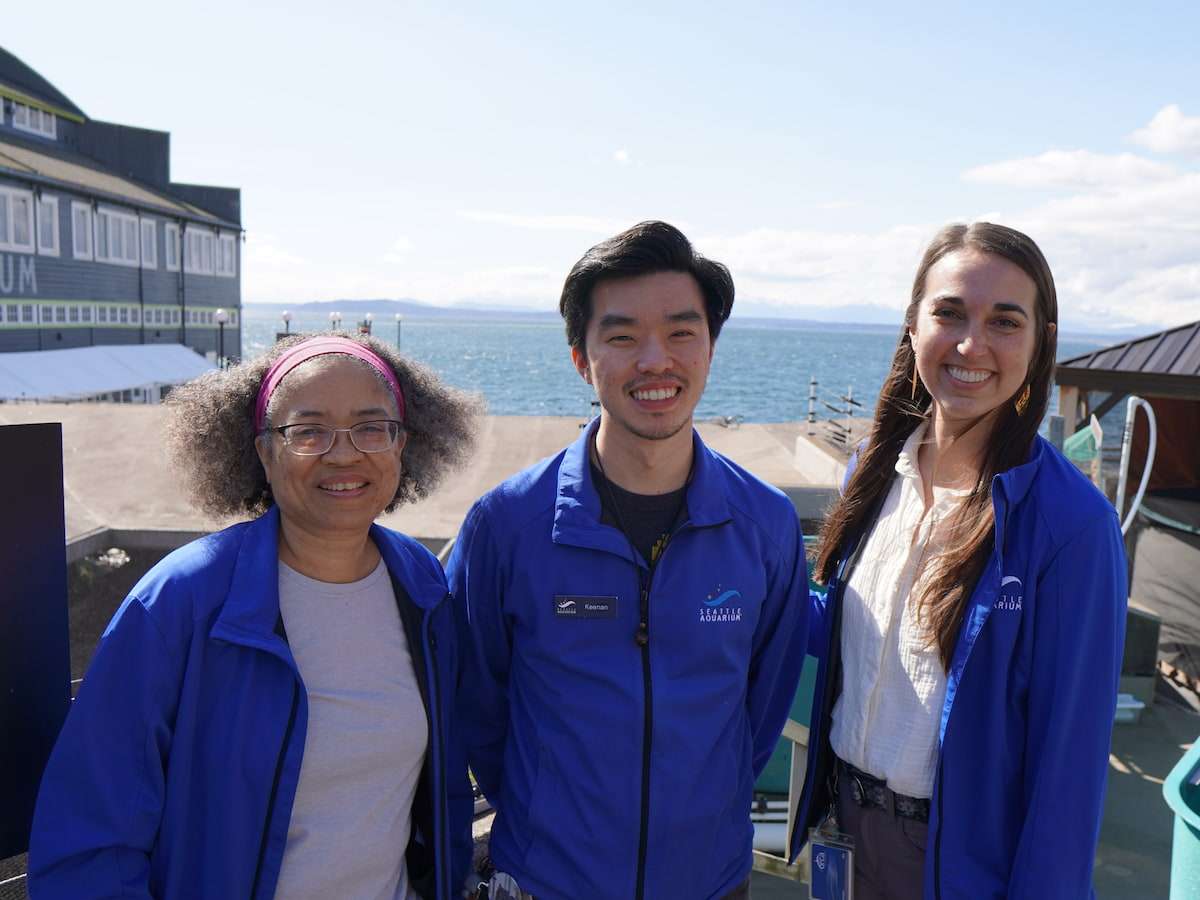
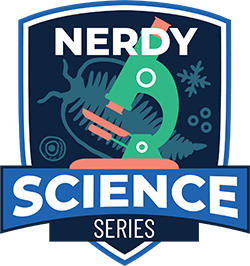
This story is part of our Nerdy Science Series—how we’re using research and technology in service of a healthy ocean.
From basket stars to fur seals, what do all animals at the Seattle Aquarium have in common? They need just the right conditions in their water to flourish. The mission of maintaining the Aquarium’s water quality every minute of every day is undertaken by a small but skilled group of chemists using both new technology and ancient solutions.
Water Quality Manager Hannah Mewhirter says her team is usually the first to notice when there’s a problem with a habitat’s water. That’s mainly because many water quality issues don’t change the water’s appearance.
The team tests 20–40 water samples from the main Aquarium and offsite Animal Care Center each day. They check several physical properties of the water like salinity, pH levels, dissolved oxygen levels and temperature. And they test for nutrients like ammonia, nitrate, nitrite and phosphate. All these parameters need to be balanced for aquatic animals to thrive.
The team also collects daily data, which helps them identify changes and guides their actions. When they notice an imbalance, they work with members of the engineering team and animal care teams to identify what caused the issue and how to amend it.
“It’s a collaborative process,” Hannah says. “We tell the animal care teams what their water quality looks like. They tell us what they need for their animals, and we work together. It’s like creating a customized plan.”
Many species at the Aquarium are from the Puget Sound region. To accommodate them, the Aquarium brings in seawater from Elliott Bay. After a little filtration and supplementation, this water is pumped into our animal habitats. We then filter and return the water back into Puget Sound.

Although seawater looks like an unlimited resource, it’s not. We want to be the best stewards of that seawater because it is the lifeblood of the Seattle Aquarium.
The Ocean Pavilion—which opens in 2024 and will feature tropical plants, fish and invertebrates from the Coral Triangle region of the Pacific Ocean—uses a different system. It’s designed to clean and recirculate 96% of the salt water in its habitats, saving both water and energy. Recaptured heat from the warm water will also help heat the building.
“The Seattle Aquarium has embraced a paradigm shift,” Hannah says. “Water quality is far more complex and sensitive in a closed-mode aquarium than in an open-flow aquarium. That will require daily testing and looking at more parameters because we are intentional about reusing the water.”
Innovative technology helps the team stay on top of water quality testing. One tool that Hannah is particularly excited about is the ion chromatograph, which tests nine different chemical properties at once. The tool not only cuts down on the time, energy and chemical reagents needed to conduct those individual tests but also reduces the amount of plastic packaging.
“Ammonia is one of the most sensitive parameters we test,” Hannah says. “We’re never going to miss ammonia testing. If anything, we’re going to add ammonia testing, especially in a fully recirculating water system. But thinking of doing that while adding environmental costs with all that plastic—it just didn’t sit well with me. So, we’re going to pursue a greener method using an ion-selective electrode.”
These sustainable choices also align with the Aquarium’s goal of becoming a zero-waste operating facility by 2025.
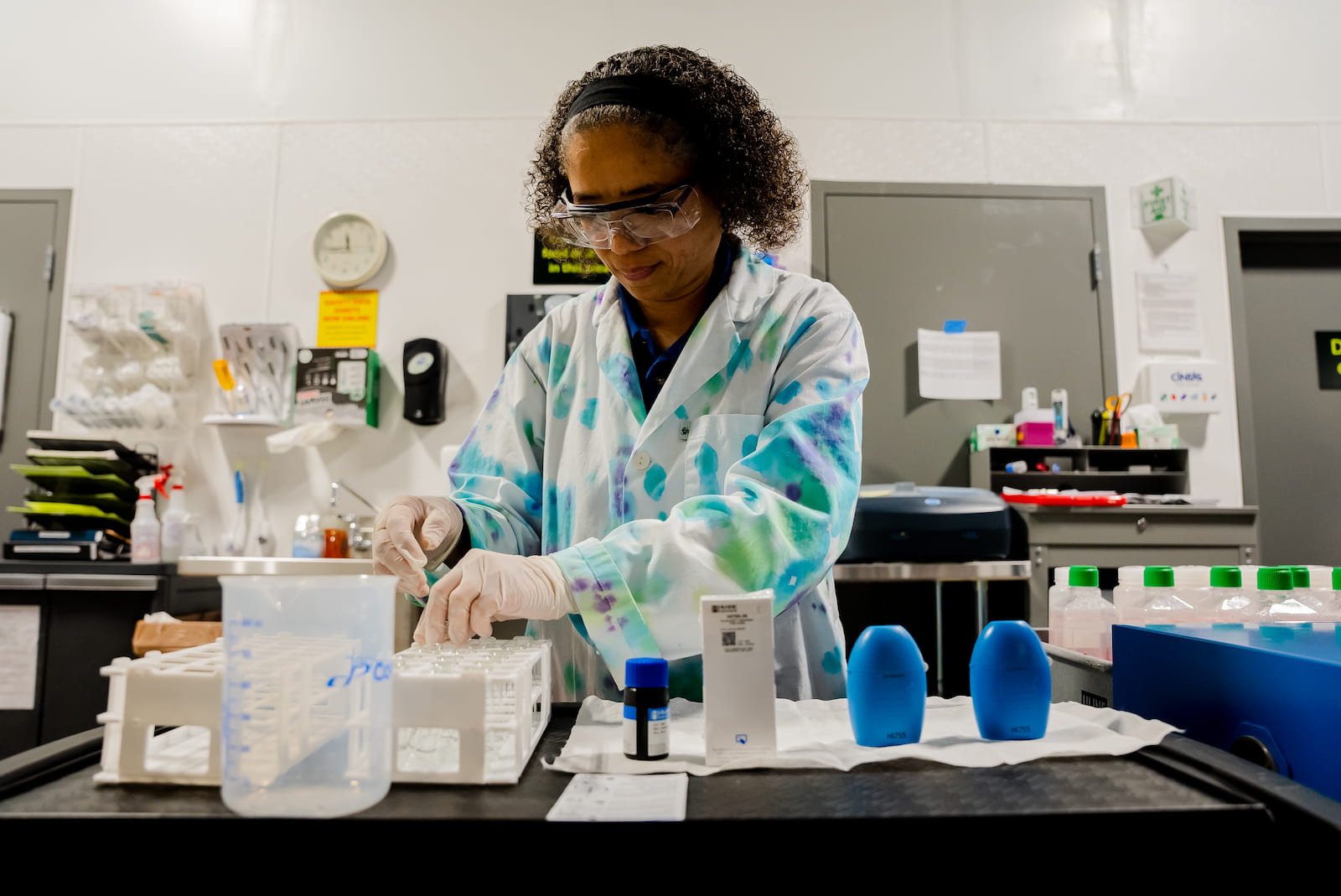
The most powerful tool the team uses to keep water clean is low-tech but no less meticulous: bacteria.
When animals eat food, they convert some of it into energy and the rest into waste products, which contain a lot of nitrogen. In large quantities, nitrogen could create harmful conditions.
Nitrifying bacteria break down the nitrogen-rich waste products and help balance the chemistry in animal habitats. These bacteria create their own waste that other bacteria eat in turn, creating a sustainable cycle. The water quality team monitors the bacterial population to create a biological filtration system that maintains water quality 24/7.
Hannah sees her work as a puzzle with many pieces. Chemistry, creativity and collaboration help Hannah and her team keep the Aquarium’s water in the clear.
“Things are relatively stable from day to day—and we want them to be. But when they’re not, that is a challenge that brings out the joy of problem-solving. I like figuring out what has changed and collaborating on how we need to fix it,” Hannah says.
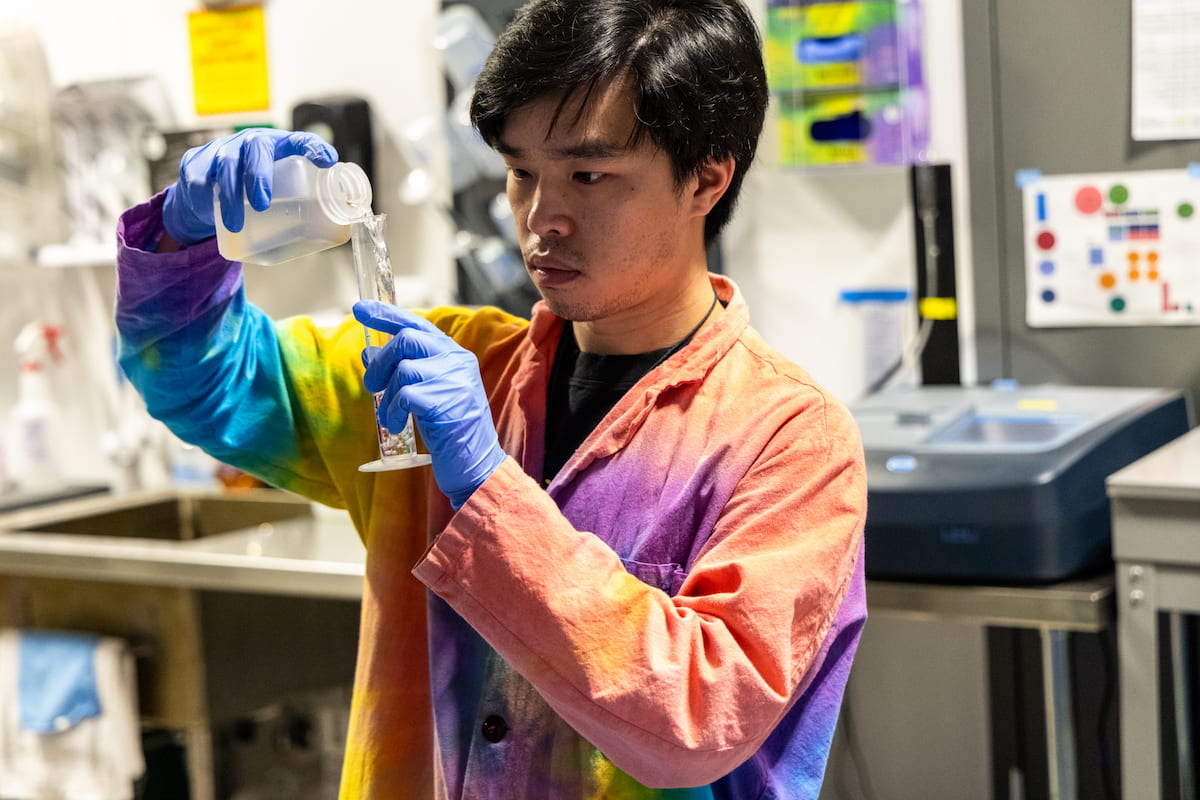
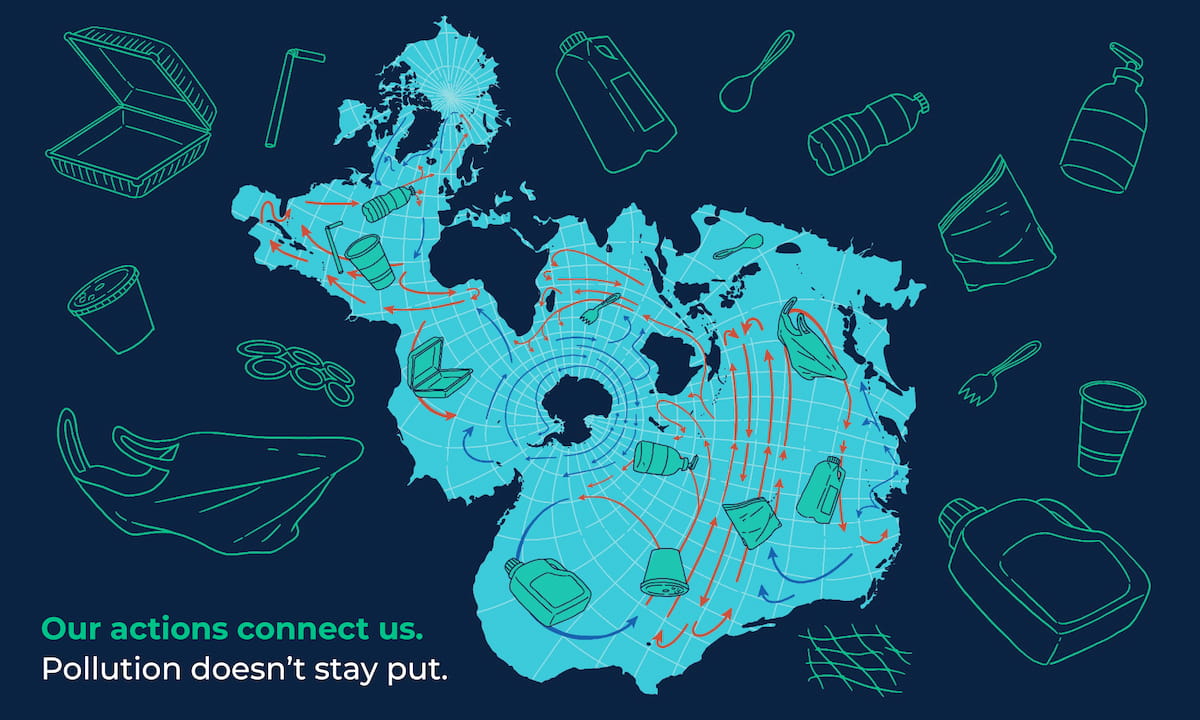
Why is the Seattle Aquarium bringing tropical ecosystems to people in Seattle? After all, the Pacific Northwest, our own backyard, is home to vibrant and diverse marine life.
That’s certainly true. What’s also true is that ocean health is part of a bigger picture. Actions by people in other parts of the world impact our local waters and the animals who live there. And what we do here affects animals and waters far away.
Regenerating a healthy ocean begins with understanding how one ocean connects us all.
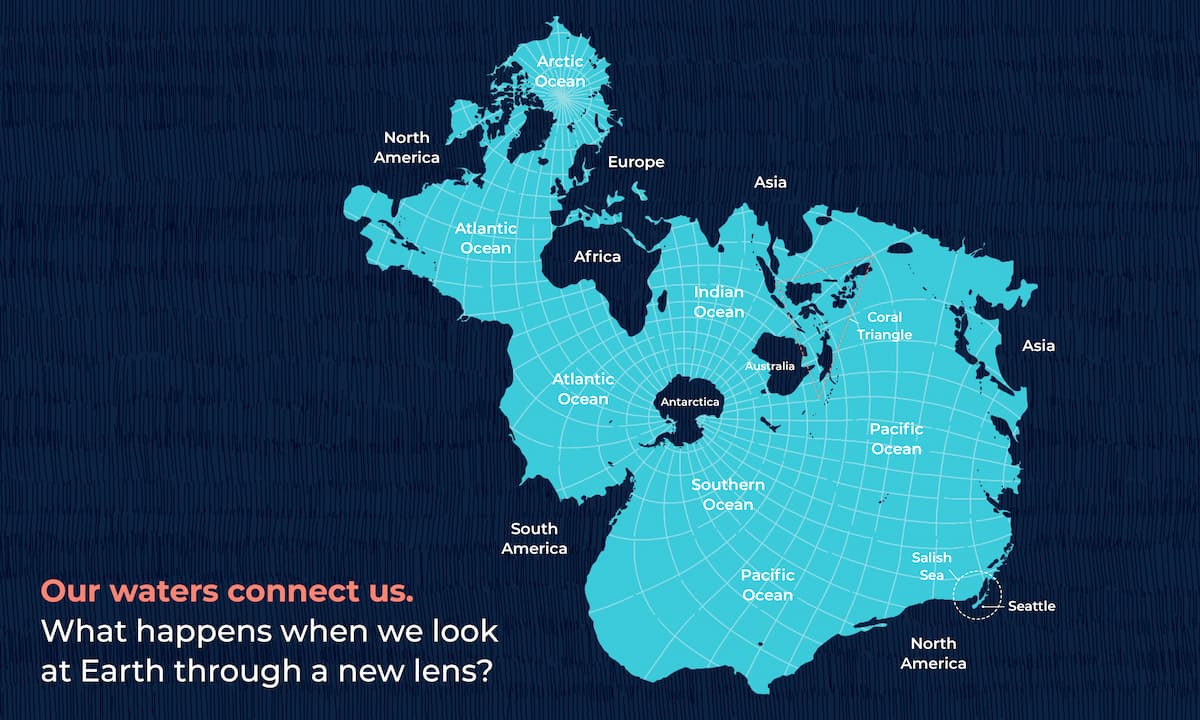
In school, many of us learned about five oceans or seven seas. A mind-bending image called the Spilhaus Projection shows us another way of looking at the blue planet. It focuses our gaze on one connected ocean, a place where animals move freely across vast, borderless waters. Can you spot home on this map?

Scientists have identified human-made chemicals and plastic debris in the deepest, most inaccessible parts of the ocean, ferried there by a complex system of currents. What’s more, the carbon we emit into the atmosphere makes the ocean warmer and more acidic everywhere. How we live and the actions of our businesses and governments affect the health of our entire planet.
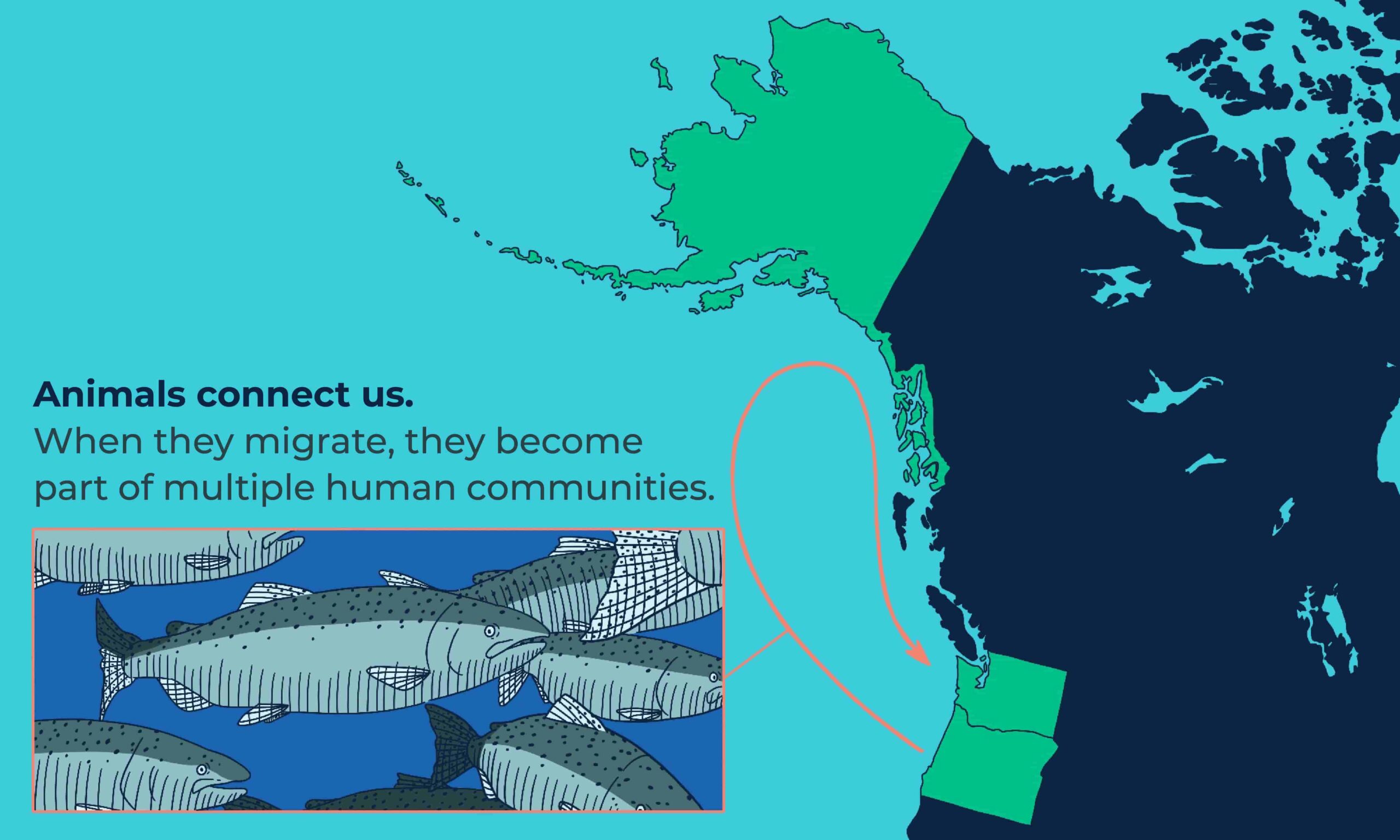
Marine animals hold cultural and economic importance to people in multiple regions. For example, some “Alaskan wild-caught” salmon spawned in Washington streams (or hatcheries) just a few years earlier. Policies to protect salmon here also protect the livelihoods of people in Alaska. And likewise, how fishing is managed in Alaska affects salmon populations here and local animals that feed on them, including critically endangered southern resident orcas. As climate change drives some animals into unfamiliar waters, new communities will join their network of stewards. Now consider how these ideas apply to an animal with a huge migratory range, like a humpback whale! Some humpback whales can migrate 3,000 miles, from the waters off Alaska to the waters of Hawaiߵi. Imagine all the other ecosystems and communities they touch!
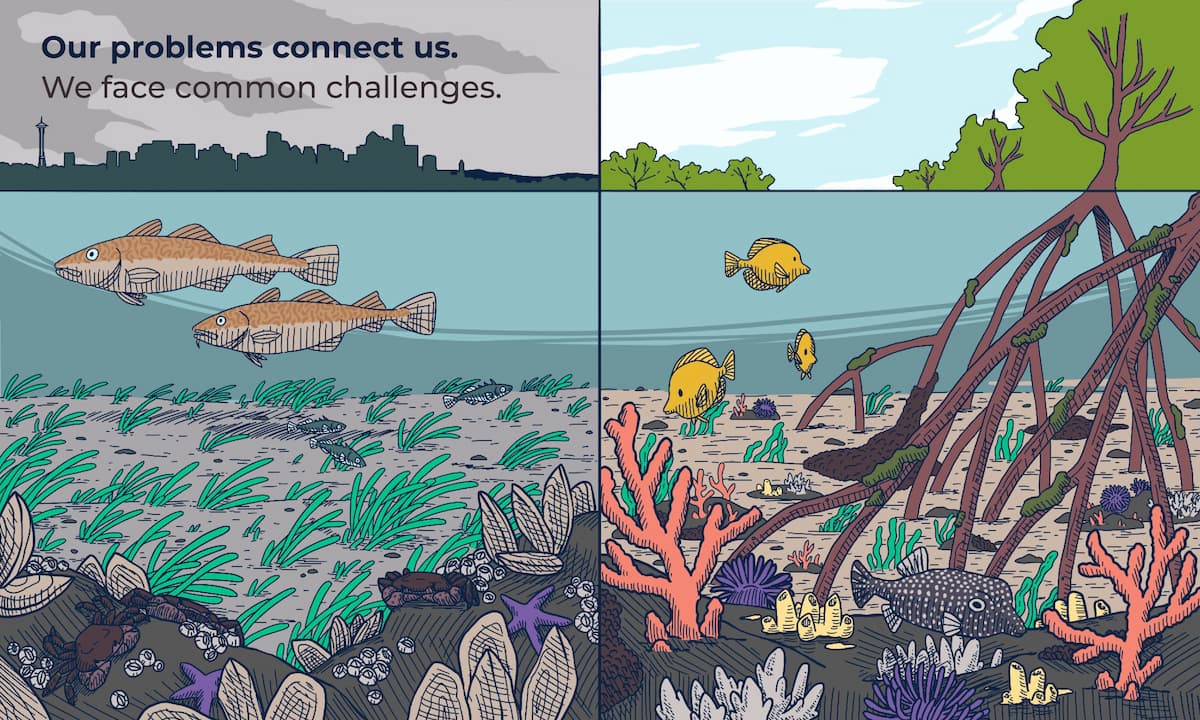
Like the Salish Sea, the Coral Triangle is a place of beauty and biodiversity. Because of the number and variety of species in the Coral Triangle, some people call it the “Amazon rainforest” of the ocean. Sadly, in both the Salish Sea and Coral Triangle, overfishing, pollution, development and climate change are taking a heavy toll. We’re losing iconic animals (like orcas and whale sharks), habitats that serve as fish nurseries (like eelgrass and mangrove forests) and important species that are sensitive to changes in ocean acidity (like oysters and coral reefs). We have much more in common than it might seem.
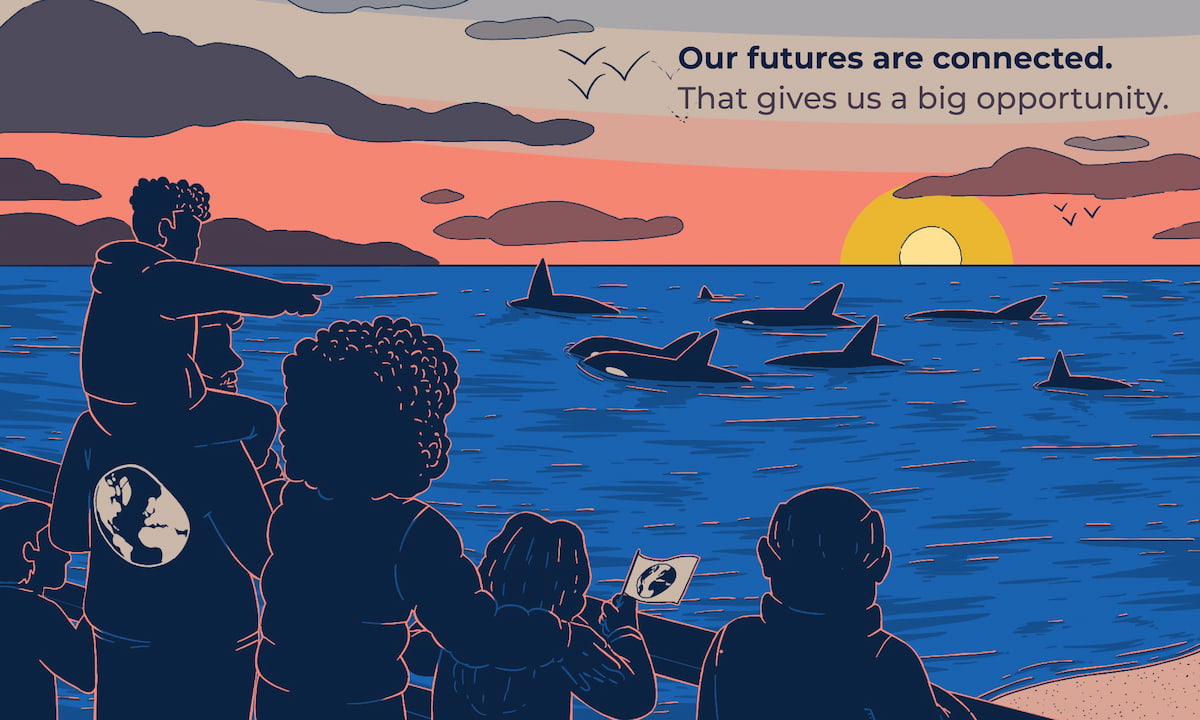
Shared problems can mean shared solutions—and hope. Did you know that governments in all six Coral Triangle countries—Indonesia, Malaysia, the Philippines, Papua New Guinea, Timor Leste and the Solomon Islands—have established marine protected areas that strictly manage human activities? Similarly, the Olympic Coast National Marine Sanctuary helps animals off the coast of Washington thrive. Bans on lightweight plastic bags, a major contributor to ocean pollution, have flourished in recent years. In addition to states like Washington, countries including Botswana, Haiti, Morocco, New Zealand and dozens of others have banned them. Rewilding initiatives—like ReShark, which was cofounded by the Seattle Aquarium and has 90+ global partners—are breeding and restoring wild populations of threatened species. Young people, including the Seattle Aquarium’s Youth Ocean Advocates, are making their voices heard worldwide. Indigenous communities around the world are playing leading roles in the climate justice movement. Looking for a way into this work? There are many. Find an effort that excites you and get involved.
When the Aquarium’s new Ocean Pavilion opens in 2024, you’ll be able to explore habitats that reflect the exquisite biodiversity of the Coral Triangle and the precious animals there. You’ll hear stories about leaders who are making a difference in ocean health. And get ready to join them!
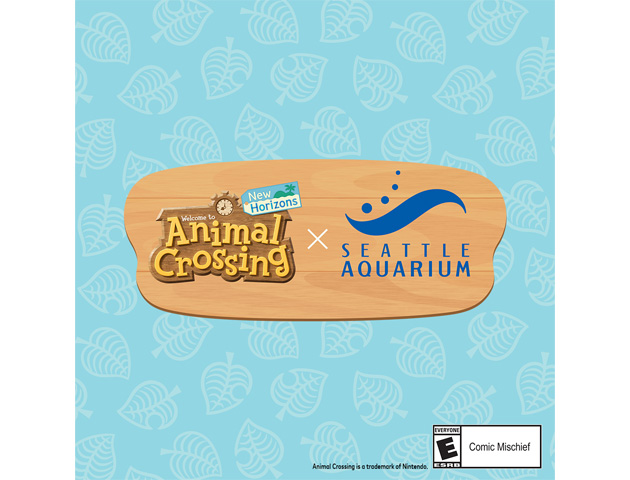
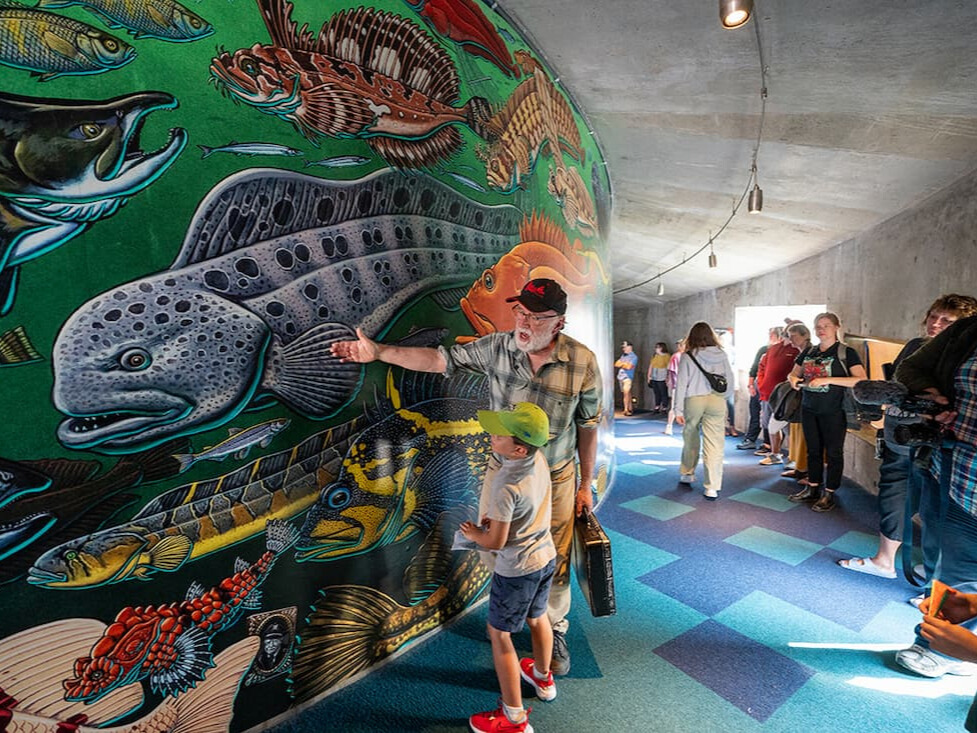
The Seattle Aquarium is proud to display two new murals from celebrated artists Ray Troll, Grace Freeman and the late Marvin E. Oliver (Quinault/Isleta Pueblo). “Salish Seascape” and “Ocean Travelers” now adorn the walls of the Aquarium’s Marine Mammals habitat.
“Salish Seascape” celebrates the diverse array of life that make their homes in and along the Salish Sea, which is a coastal extension of the Pacific Ocean that includes Puget Sound. The fish are drawn in Ray’s signature style, which has been dubbed “scientific surrealism.” For this piece, Ray dug deep into the catalog of drawings he’s created over his decades-long career. Many of the fish featured in this mural are ones Ray originally created for the University of Washington in 2010.
“This mural is a combination of a career’s worth of work with all my fish stuff from the Pacific Northwest,” Ray says.
The mural came to life when artist Grace Freeman digitized Ray’s designs and added her own touches, like the mermaid swimming around in the upper right section. The artists added other hidden gems to the seascape, including a pencil, paintbrush and portrait of Ivar Haglund, founder of the seafood restaurant chain Ivar’s.

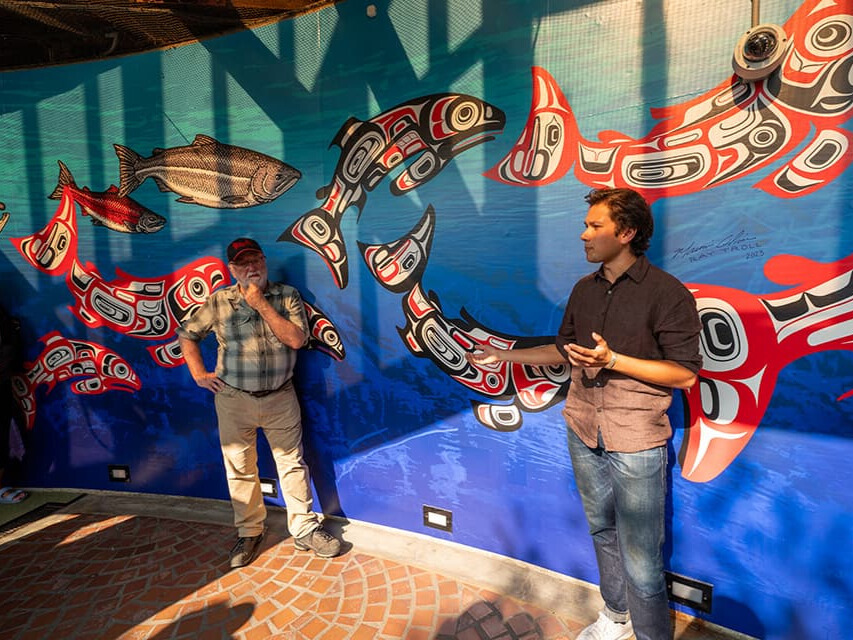
“Ocean Travelers” features a run of salmon in the styles of Ray and the late Coast Salish artist Marvin E. Oliver. Ray and Marvin ran adjacent art studios in Ketchikan, Alaska before Marvin passed in 2019. Throughout their long friendship, they discussed doing a collaborative piece. This mural fulfills that wish.
“A friend of mine once said that art stands in the river of time,” Ray says. “And I’ve always liked that phrase. Marvin is no longer with us. But Marvin is still with us through his art.”
Marvin’s son, artist Owen Oliver (Quinault/Isleta Pueblo), said the work is a testament to the friendship between his father and Ray. It also pays homage to Indigenous values, as Coast Salish people have looked after these waters since time immemorial and continue to do so today.
Ray has lived in Ketchikan for the past 40 years, but Seattle holds a special place in his heart. He moved to the city in 1977—the same year the Aquarium opened—and sold his prints at Pike Place Market. Since then, he’s spent a lot of time at the Aquarium because he considers it one of the best places to see fish in action without having to take a dive.
Ray has long been fascinated with underwater creatures, a feeling he hopes to share through his art. He’s proud to have his work displayed in the Aquarium that helped feed his curiosity and continues to inspire that same feeling in others.
“If you get people to stop for a second and marvel at something as tiny as a Pacific spiny lumpsucker, you have fostered a sense of wonder and awe and fascination,” Ray says. “And if you become fascinated by something, you begin to care for it.”
The Aquarium would like to thank Marvin’s family, Ray and Grace for allowing us to display their art. We are proud to showcase art from such talented, passionate people who care deeply about nature. These murals reflect our S.A.L.I.S.H. values, which include inspiring a sense of excited curiosity in our guests and honoring the Indigenous peoples who were the original stewards of this area and currently play a valuable role in guiding its conservation.
Come check out the new murals on your next visit to the Aquarium.
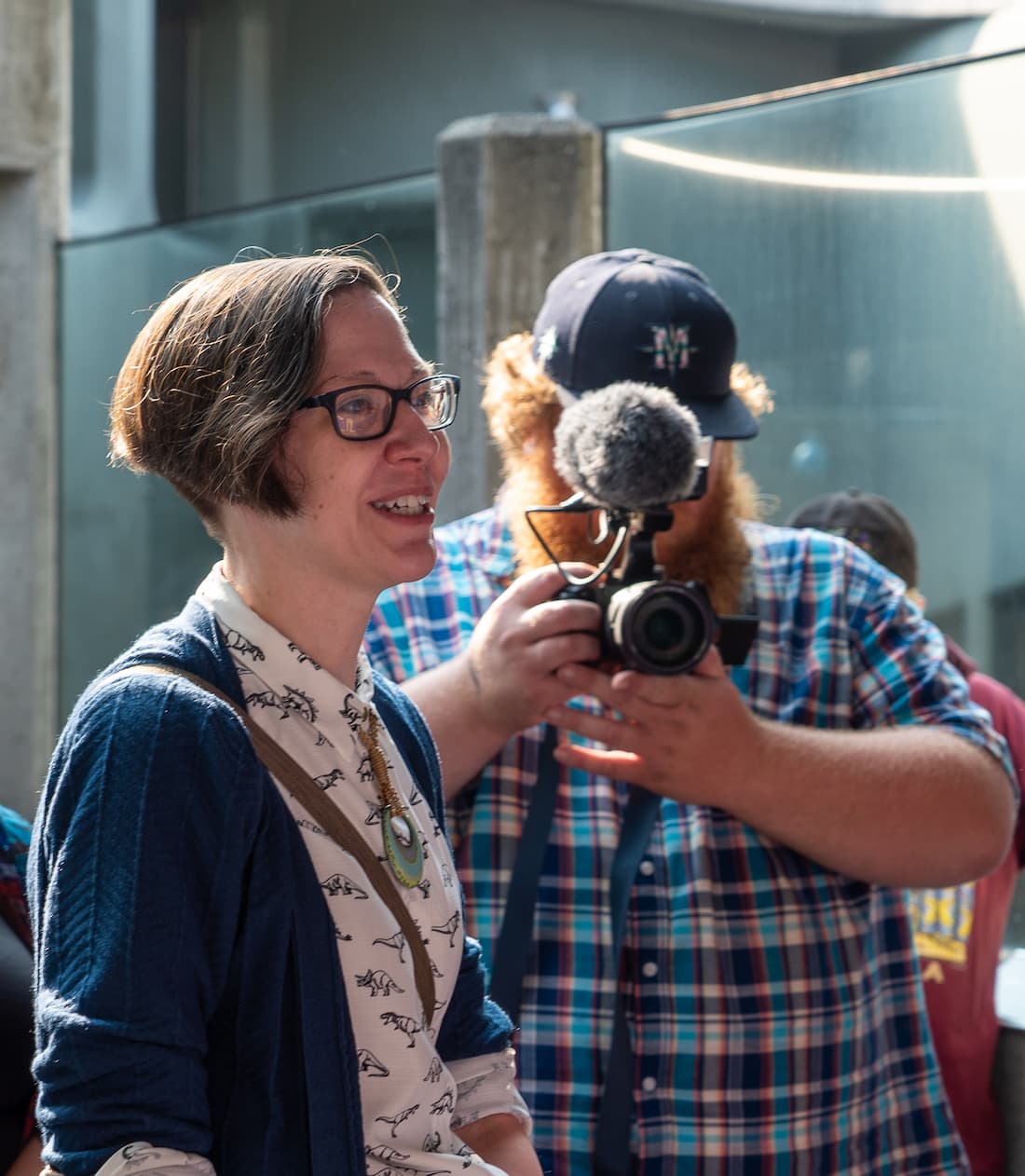
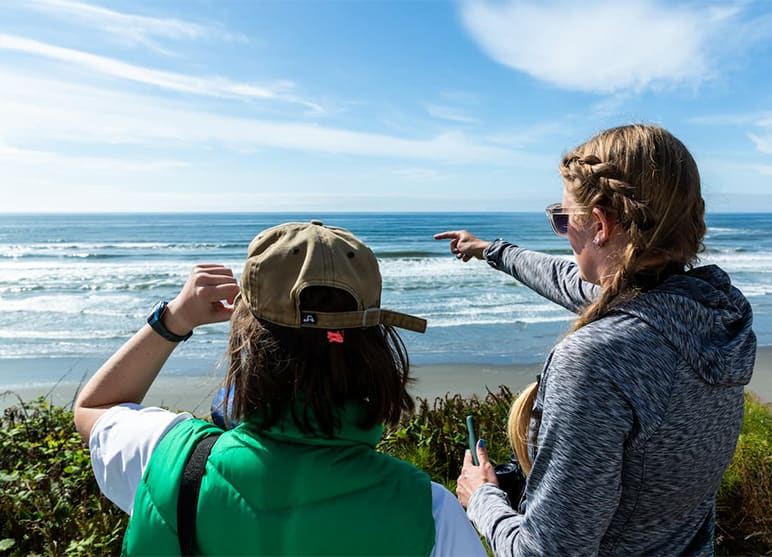

This story is part of our Nerdy Science Series—how we’re using research and technology in service of a healthy ocean.
Guests at the Seattle Aquarium know how fun it is to watch sea otters eat and play. But for sea otter researchers, watching these adorable animals on Washington’s outer coast also provides valuable scientific information. By keeping track of wild sea otter populations through regular surveys, Dr. Shawn Larson of the Seattle Aquarium and her team hope to better understand the important role otters play in the marine ecosystem and what the future might hold for them.
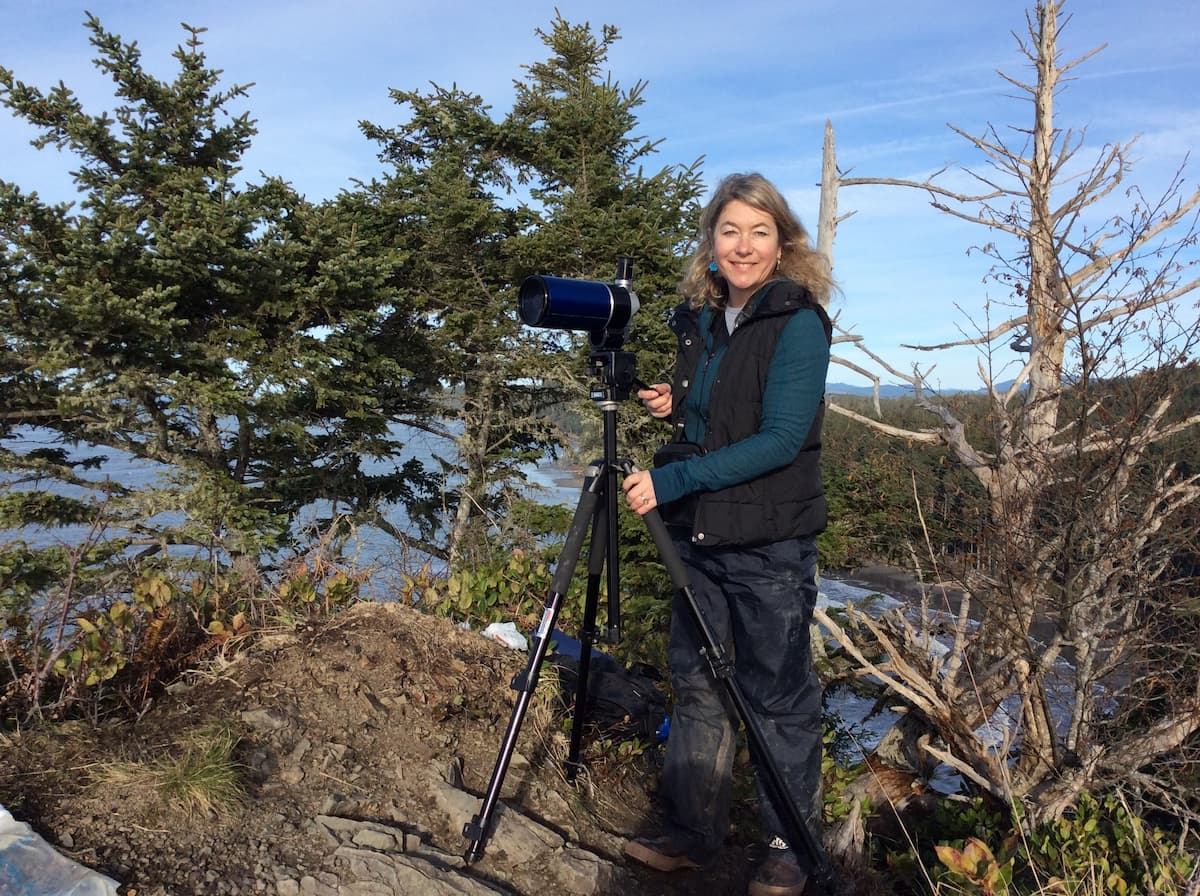
Each June for the past 23 years, Seattle Aquarium researchers have participated in a statewide, multiday survey of the Washington sea otter population, organized by the U.S. Fish and Wildlife Service and the Washington State Department of Fish and Wildlife.
Shawn and other Seattle Aquarium staff assist by forming ground teams at specific locations along the coast to carefully count all the otters in an area. The team usually leaves bright and early to hike to the observation point, where they set up their spotting scopes and start looking for otters.
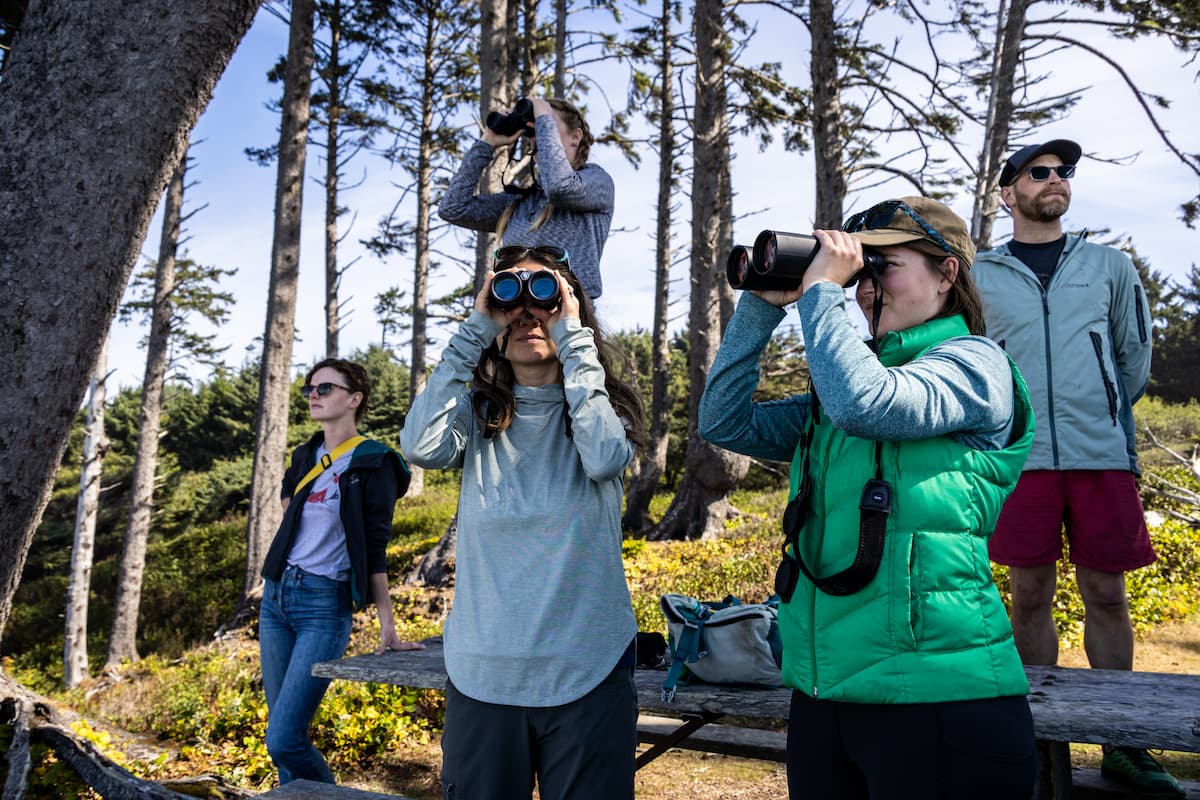
They also record information on the otters’ ages and behaviors. During the survey, a plane circles above large groups of otters—known as rafts—to take high-quality digital photographs. Researchers count the otters in these photos later.
The otters tend to float about a kilometer (a little over half a mile) from the shore in groups of up to 1,000. It can be hard, at that distance, to distinguish rafts from clumps of kelp floating nearby. But Shawn, a seasoned otter spotter, knows to look for heads and flippers. Otters also tend to appear black, while kelp looks dark brown.
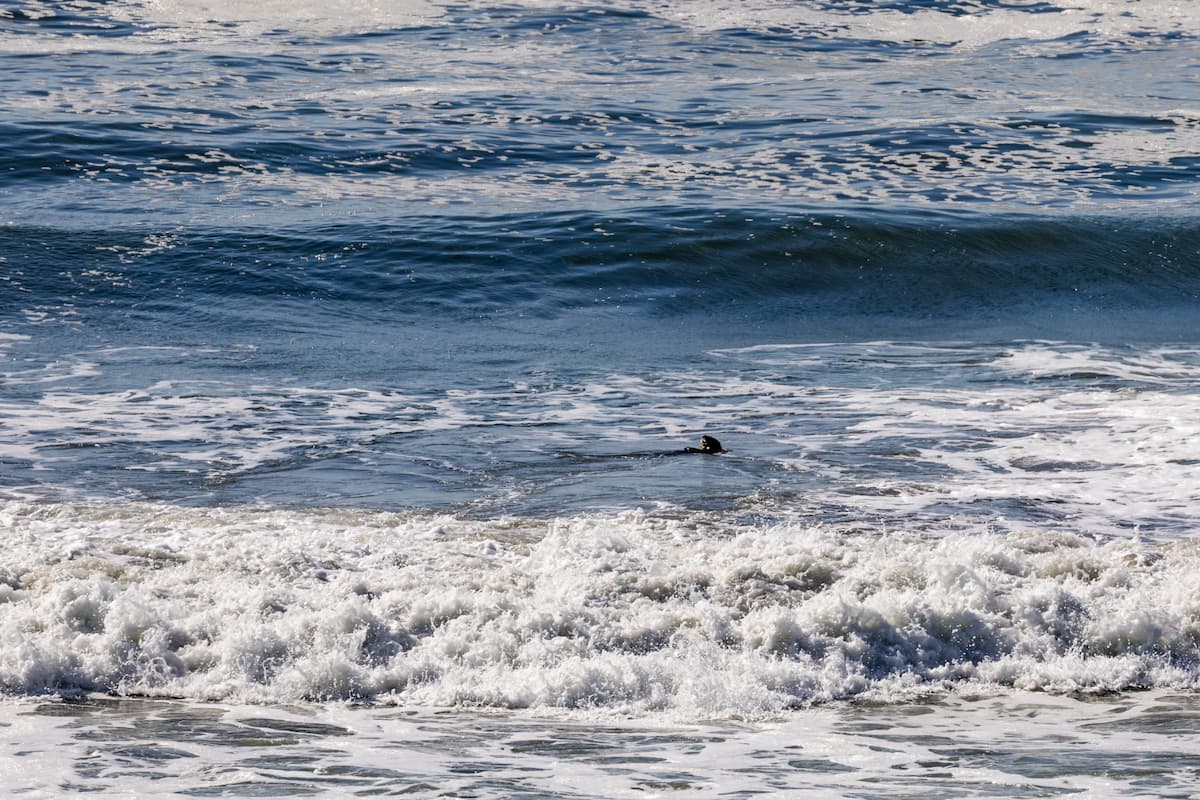
The Seattle Aquarium also does surveys of the local population monthly, documenting their numbers and diets. Like us, otters have preferred foods. If they’re available, otters will go for sea urchins, crabs and clams. When those become scarce, otters will turn to snails, mussels and sea cucumbers. Shawn has even seen otters eat a giant Pacific octopus!
“Their diet starts to diversify…and that’s when we know that their population has pretty much reached its carrying capacity—meaning the limit for that area,” Shawn says.
Happily, the sea otters in Washington are doing well. Their population is steadily growing with an increase of about 10% each year. They’re growing large and raising many pups, suggesting that these days, there’s plenty of their favorite foods on the outer coast.
Despite decades of research, scientists are still uncovering new information about sea otters. We know that otters eat sea urchins that would otherwise consume kelp. So, where there are otters, there are usually also healthy kelp forests, which serve as habitats for an array of nearshore marine life. However, researchers seek a deeper understanding of how sea otters impact nearshore environments.
"They're kind of a mystery in a lot of ways. There's a lot we do know about them, but there's a lot we don’t."
Dr. Shawn Larson, senior conservation research manager, Seattle Aquarium
“We know that sea otters tend to structure the nearshore where they live, but exactly how does that work? What are the pieces of the puzzle that make it work?” Shawn says.
To unravel the mystery, the Aquarium is in the early stages of using a remotely operated vehicle, or ROV, to study otter foraging behavior in kelp forests on the outer coast. By going underwater to where the action is, the ROV will provide in-depth footage and data on sea otter foraging behavior.
A better understanding of sea otters and kelp can’t come soon enough. Kelp is highly effective at sequestering carbon, which could help offset some effects of climate change.
"I hope that we continue to do this work for decades to come… The food sea otters are able to catch really will show how they are able to adapt or not to oceanic changes."
Dr. Shawn Larson, senior conservation research manager, Seattle Aquarium
Another question researchers are exploring is how sea otters will react to climate change.
With up to 1 million hairs per square inch, their dense coats keep them warm in the chilly waters of the Pacific. But otters have trouble expelling heat. Rising ocean temperatures could push them farther north. At the same time, otters tend to thrive in nearshore environments. Rising sea levels and melting sea ice could provide more habitat for them.
“We just don’t know. There could be dramatic negatives with climate change for sea otters and there could be dramatic positives,” Shawn says.
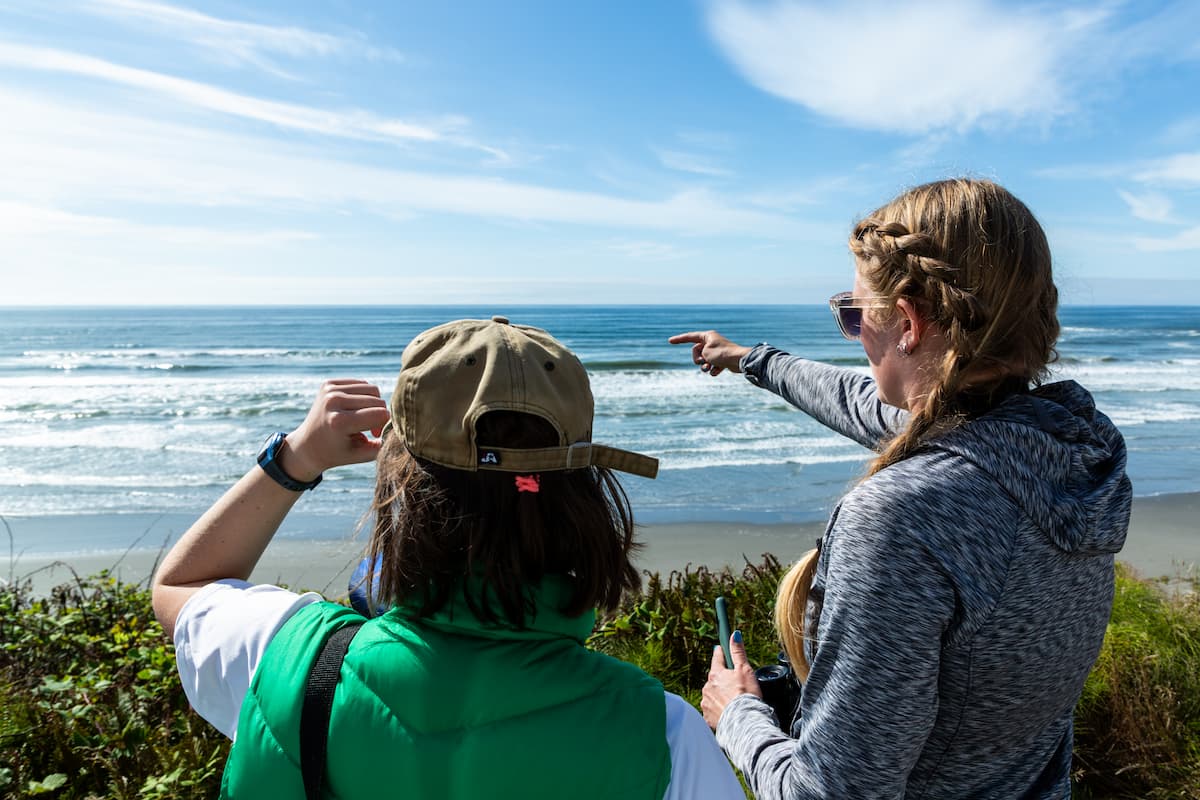
One thing we do know is that sea otters need a clean home. Trash that ends up in the sea can reach them via ocean currents. By properly disposing of trash, you can help keep the ocean clean for sea otters and other marine life.
Consider reducing plastic consumption and choosing reusable options when you can. Better yet, volunteer at a beach cleanup to remove plastic and other trash from our shores. You can even get your friends involved!
For more ways to help the ocean and all that depend on it (including humans!) check out our Act for the Ocean page.